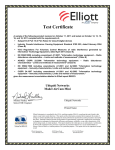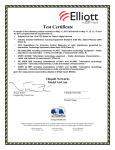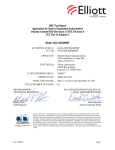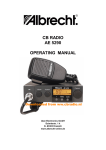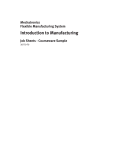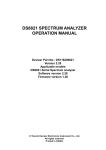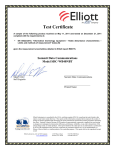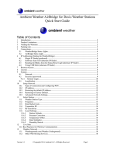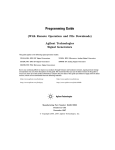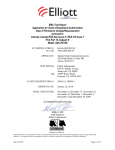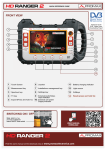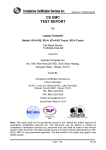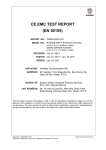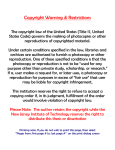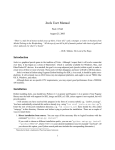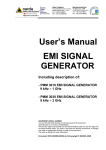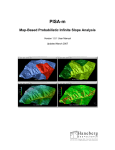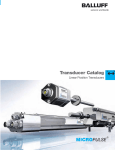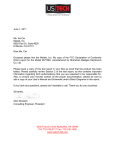Download EMC Test Data - Ubiquiti Networks
Transcript
Test Certificate A sample of the following product received on August 26, 2011 and tested on August 26, 29, & 30, September 1 & 2, and October 17, 2011 complied with the requirements of, Subpart B of Part 15 of FCC Rules for Class A digital devices Industry Canada Interference Causing Equipment Standard ICES 003, dated February 2004 (Class A) VCCI Regulations For Voluntary Control Measures of radio interference generated by Information Technology Equipment, dated April 2011 (Class A). EN 55022:2006 including amendment A1:2007, "Information technology equipment – Radio disturbance characteristics – Limits and methods of measurement" (Class A) CISPR 22:2008 "Information technology equipment – Radio disturbance characteristics – Limits and methods of measurement" (Class A) AS/NZS CISPR 22:2006 "Information technology equipment characteristics – Limits and methods of measurement" (Class A) EN 55024:1998 including amendments A1:2001 and A2:2003 "Information technology equipment – Immunity characteristics, Limits and method of measurement." – Radio disturbance CISPR 24:1997 including amendments A1:2001 and A2:2002 "Information technology equipment – Immunity characteristics, Limits and method of measurement." given the measurement uncertainties detailed in Elliott report R85225. Ubiquiti Networks Model AirCam Dome _____________________ David W. Bare Chief Engineer _______________________ Ubiquiti Networks _______________________ Printed Name Elliott Laboratories is accredited by the A2LA, certificate number 2016.01, to perform the test(s) listed in this report, except where noted otherwise. This report and the information contained herein represent the results of testing test articles identified and selected by the client performed to specifications and/or procedures selected by the client. National Technical Systems (NTS) makes no representations, expressed or implied, that such testing is adequate (or inadequate) to demonstrate efficiency, performance, reliability, or any other characteristic of the articles being tested, or similar products. This report should not be relied upon as an endorsement or certification by NTS of the equipment tested, nor does it represent any statement whatsoever as to its merchantability or fitness of the test article, or similar products, for a particular purpose. This report shall not be reproduced except in full Elliott Laboratories www.elliottlabs.com 41039 Boyce Road Fremont, CA. 94538 510-578-3500 Phone 510-440-9525 Fax EMC Test Report Class A Information Technology Equipment Class A Digital Device FCC Part 15; Industry Canada ICES 003 VCCI Regulations 2011 EN 55022:2006 + A1:2007; CISPR 22:2008 AS/NZS CISPR 22:2006 EN 55024:1998 +A1:2001 +A2:2003 CISPR 24:1997 + A1:2001 + A2:2002 Model: AirCam Dome COMPANY: TEST SITE(S): REPORT DATE: FINAL TEST DATES: TOTAL NUMBER OF PAGES: PROGRAM MGR / TECHNICAL REVIEWER: ______________________________ David W. Bare Chief Engineer Ubiquiti Networks 91 E. Tasman Drive San Jose, CA 95134 Elliott Laboratories 41039 Boyce Road Fremont, CA. 94538-2435 November 10, 2011 August 26, 29, & 30, September 1 & 2, and October 17, 2011 79 QUALITY ASSURANCE DELEGATE / FINAL REPORT PREPARER: ______________________________ Chandra Morris Quality Assurance Representative Elliott Laboratories is accredited by the A2LA, certificate number 2016.01, to perform the test(s) listed in this report, except where noted otherwise. This report and the information contained herein represent the results of testing test articles identified and selected by the client performed to specifications and/or procedures selected by the client. National Technical Systems (NTS) makes no representations, expressed or implied, that such testing is adequate (or inadequate) to demonstrate efficiency, performance, reliability, or any other characteristic of the articles being tested, or similar products. This report should not be relied upon as an endorsement or certification by NTS of the equipment tested, nor does it represent any statement whatsoever as to its merchantability or fitness of the test article, or similar products, for a particular purpose. This report shall not be reproduced except in full File: R85225 Page 2 Elliott Laboratories -- EMC Department Test Report Report Date: November 10, 2011 REVISION HISTORY Rev# - File: R85225 Date 11-10-2011 Comments Modified By First release Page 3 Elliott Laboratories -- EMC Department Test Report Report Date: November 10, 2011 TABLE OF CONTENTS REVISION HISTORY................................................................................................................................................3 TABLE OF CONTENTS ............................................................................................................................................4 SCOPE..........................................................................................................................................................................6 OBJECTIVE ................................................................................................................................................................6 STATEMENT OF COMPLIANCE...........................................................................................................................7 DEVIATIONS FROM THE STANDARDS..............................................................................................................7 INFORMATION TECHNOLOGY EQUIPMENT EMISSIONS TEST RESULTS ............................................8 CONDUCTED EMISSIONS (MAINS PORT) ........................................................................................................8 CONDUCTED EMISSIONS (TELECOMMUNICATIONS PORTS) ....................................................................8 RADIATED EMISSIONS........................................................................................................................................8 INFORMATION TECHNOLOGY EQUIPMENT IMMUNITY TEST RESULTS.............................................9 MEASUREMENT UNCERTAINTIES ...................................................................................................................10 EQUIPMENT UNDER TEST (EUT) DETAILS....................................................................................................11 GENERAL..............................................................................................................................................................11 OTHER EUT DETAILS.........................................................................................................................................11 ENCLOSURE.........................................................................................................................................................11 MODIFICATIONS.................................................................................................................................................11 SUPPORT EQUIPMENT.......................................................................................................................................11 EUT INTERFACE PORTS ....................................................................................................................................11 EUT OPERATION .................................................................................................................................................12 EMISSIONS TESTING ............................................................................................................................................13 RADIATED AND CONDUCTED EMISSIONS...................................................................................................13 RADIATED EMISSIONS CONSIDERATIONS .....................................................................................13 CONDUCTED EMISSIONS CONSIDERATIONS .................................................................................13 EMISSIONS MEASUREMENT INSTRUMENTATION .....................................................................................14 RECEIVER SYSTEM ............................................................................................................................................14 INSTRUMENT CONTROL COMPUTER ............................................................................................................14 LINE IMPEDANCE STABILIZATION NETWORK (LISN)...............................................................................14 IMPEDANCE STABILIZATION NETWORK (ISN) ...........................................................................................14 FILTERS/ATTENUATORS ..................................................................................................................................14 ANTENNAS...........................................................................................................................................................15 ANTENNA MAST AND EQUIPMENT TURNTABLE .......................................................................................15 INSTRUMENT CALIBRATION...........................................................................................................................15 EMISSIONS TEST PROCEDURES .......................................................................................................................16 EUT AND CABLE PLACEMENT ........................................................................................................................16 CONDUCTED EMISSIONS (MAINS) .................................................................................................................16 RADIATED EMISSIONS (SEMI-ANECHOIC AND/OR OATS TEST ENVIRONMENT) ................................17 Preliminary Scan........................................................................................................................................17 Final Maximization....................................................................................................................................17 RADIATED EMISSIONS (FREE-SPACE TEST ENVIRONMENT) ..................................................................18 Preliminary Scan........................................................................................................................................18 Final Maximization....................................................................................................................................18 SAMPLE CALCULATIONS ...................................................................................................................................19 SAMPLE CALCULATIONS - CONDUCTED EMISSIONS ...............................................................................19 SAMPLE CALCULATIONS - RADIATED EMISSIONS....................................................................................19 IMMUNITY TESTING ............................................................................................................................................20 GENERAL INFORMATION.................................................................................................................................20 File: R85225 Page 4 Elliott Laboratories -- EMC Department Test Report Report Date: November 10, 2011 IMMUNITY MEASUREMENT INSTRUMENTATION .....................................................................................20 ELECTROSTATIC DISCHARGE TEST SYSTEM..............................................................................................20 ELECTROMAGNETIC FIELD TEST SYSTEM ..................................................................................................20 ELECTRICAL FAST TRANSIENT/BURST TEST SYSTEM .............................................................................20 SURGE TEST SYSTEM ........................................................................................................................................20 CONDUCTED INTERFERENCE TEST SYSTEM ..............................................................................................20 VOLTAGE VARIATION TEST SYSTEM ...........................................................................................................21 INSTRUMENT CALIBRATION...........................................................................................................................21 IMMUNITY TEST PROCEDURES .......................................................................................................................21 EQUIPMENT PLACEMENT ................................................................................................................................21 APPLICATION OF ELECTROSTATIC DISCHARGES .....................................................................................22 APPLICATION OF ELECTROMAGNETIC FIELD ............................................................................................22 APPLICATION OF ELECTRICAL FAST TRANSIENTS ...................................................................................22 APPLICATION OF SURGES................................................................................................................................22 APPLICATION OF CONDUCTED INTERFERENCE ........................................................................................22 APPLICATION OF VOLTAGE VARIATIONS ...................................................................................................22 APPENDIX A TEST EQUIPMENT CALIBRATION DATA ..............................................................................23 APPENDIX B TEST DATA .....................................................................................................................................25 APPENDIX C PRODUCT LABELING REQUIREMENTS ................................................................................71 APPENDIX D USER MANUAL REGULATORY STATEMENTS ....................................................................72 APPENDIX E ADDITIONAL INFORMATION FOR VCCI...............................................................................73 APPENDIX F ADDITIONAL INFORMATION FOR AUSTRALIA AND NEW ZEALAND .........................74 APPENDIX G BASIC AND REFERENCE STANDARDS...................................................................................75 SUBPART B OF PART 15 OF FCC RULES FOR DIGITAL DEVICES. .....................................................................75 VCCI REGULATIONS FOR INFORMATION TECHNOLOGY EQUIPMENT, DATED APRIL 2009.........................75 EN 55022:2006 INCLUDING AMENDMENT A1:2007 ...........................................................................................76 EN 55024:1998 INCLUDING AMENDMENTS A1:2001 AND A2:2003..................................................................77 CISPR 24:1997 INCLUDING AMENDMENTS A1:2001 AND A2:2002 ..................................................................78 END OF REPORT ....................................................................................................................................................79 File: R85225 Page 5 Elliott Laboratories -- EMC Department Test Report Report Date: November 10, 2011 SCOPE Governments and standards organizations around the world have published requirements regarding the electromagnetic compatibility (EMC) of electronic equipment. Testing has been performed on the Ubiquiti Networks model AirCam Dome, pursuant to the following standards. Standard FCC Part 15, Subpart B Title Radio Frequency Devices ICES-003, Issue 4 VCCI V-3 Digital apparatus VCCI Regulations For Voluntary Control Measures of radio interference generated by Information Technology Equipment Information technology equipment – Radio disturbance characteristics – Limits and methods of measurement Information technology equipment – Radio disturbance characteristics – Limits and methods of measurement Information technology equipment – Radio disturbance characteristics – Limits and methods of measurement Information technology equipment – Immunity characteristics, Limits and method of measurement CISPR 22 AS/NZS CISPR 22 EN 55022 EN 55024 CISPR 24 Information technology equipment – Immunity characteristics, Limits and method of measurement Standard Date October 2011 as Amended 2004 April 2011 2008 2006 2006 + A1:2007 1998 +A1:2001 +A2:2003 1997 +A1:2001 +A2:2002 All measurements and evaluations have been in accordance with these specifications, test procedures, and measurement guidelines as outlined in Elliott Laboratories test procedures, and in accordance with the standards referenced therein (refer to Appendix G). OBJECTIVE The objective of Ubiquiti Networks is to: declare conformity with the essential requirements of the EMC directive 2004/108/EC using the harmonized standard(s) referenced in this report; declare conformity with the electromagnetic compatibility (EMC) regulatory arrangement of the Australian Communications and Media Authority (ACMA); verify compliance with FCC requirements for digital devices and Canada’s requirements for digital devices; verify compliance to the Japanese VCCI requirements for Information Technology Equipment; File: R85225 Page 6 Elliott Laboratories -- EMC Department Test Report Report Date: November 10, 2011 STATEMENT OF COMPLIANCE The tested sample of Ubiquiti Networks model AirCam Dome complied with the requirements of: Standard/Regulation Subpart B of Part 15 of the FCC Rules (CFR title 47) ICES-003, Issue 4 VCCI Regulations V-3 EN 55022 CISPR 22 Edition 6 AS/NZS CISPR 22 Equipment Type/Class Standard Date Class A 2011 as amended Class A Class A Class A Class A Class A 2004 2011 2006 + A1:2007 2008 2006 1998 +A1:2001 +A2:2003 1997 +A1:2001 +A2:2002 EN55024 - CISPR 24 - This report is suitable for demonstrating compliance with the EMC requirements in Australia and New Zealand. Refer to Appendix F for more details. The test results recorded herein are based on a single type test of the Ubiquiti Networks model AirCam Dome and therefore apply only to the tested sample(s). The sample was selected and prepared by Jennifer Sanchez of Ubiquiti Networks. Maintenance of compliance is the responsibility of the company. Any modification of the product that could result in increased emissions or susceptibility should be checked to ensure compliance has been maintained (i.e., printed circuit board layout changes, different enclosure, different line filter or power supply, harnessing and/or interface cable changes, etc.). DEVIATIONS FROM THE STANDARDS The following deviations were made from the published requirements listed in the scope of this report: Conducted emissions on telecommunication ports tests were not performed per the standard. File: R85225 Page 7 Elliott Laboratories -- EMC Department Test Report Report Date: November 10, 2011 INFORMATION TECHNOLOGY EQUIPMENT EMISSIONS TEST RESULTS The following emissions tests were performed on the Ubiquiti Networks model AirCam Dome. The measurements were extracted from the data recorded during testing and represent the highest amplitude emissions relative to the specification limits. The complete test data is provided in the appendices of this report. Although the product is not intended for residential use, some of the tests were performed using the limits for residential use (Class B) which are more stringent than those for commercial use (Class A). CONDUCTED EMISSIONS (MAINS PORT) Frequency Range Operating Voltage 0.15-30 MHz, 120V, 60Hz 0.15-30 MHz, 220V, 60Hz 0.15-30 MHz, 230V, 50Hz Standard/Section Requirement Measurement Margin Status FCC § 15.107(a) VCCI Table 4.2 CISPR 22 Table 2 EN 55022 Table 2 AS/NZS CISPR 22 Table 2 (Class B) 0.15-0.5 MHz: 66-56 dBµV QP 56-46 dBµV Av 0.5-5.0 MHz: 56 dBµV QP 46 dBµV Av 5.0-30.0 MHz: 60 dBµV QP 50 dBµV Av 44.1dBµV @ 16.229MHz 45.7dBµV @ 16.229MHz -5.9dB Complied -4.3dB Complied 42.1dBµV @ 0.356MHz -6.7dB Complied Requirement Measurement Margin Status 30 – 230, 40 dBµV/m 230 – 1000, 47 dBµV/m (10m limit) 44.3dBµV/m @ 800.00MHz -2.7dB Complied CONDUCTED EMISSIONS (TELECOMMUNICATIONS PORTS) Testing was not performed RADIATED EMISSIONS Frequency Range 30-1000 MHz Standard/Section EN 55022 Table 5 CISPR 22 Table 5 FCC §15.109(g) VCCI Table 4.5 AS/NZS CISPR 22 Table 5 Class A 54.0 dBµV/m Av 47.7dBµV/m @ 74.0 dBµV/m Pk -6.3dB Complied 1350.1MHz (3m limit) 1 – 3GHz EN 55022 Table 7 56 dBµV/m Av CISPR 22 Table 7 76 dBµV/m Pk 1000-2000 M Hz VCCI Table 4.7 43.3dBµV/m @ 3 – 6GHz -6.7dB Complied Note 1 (Free-Space 1055.6MHz 60 dBµV/m Av Measurement) 80 dBµV/m Pk Class A (3m limit) Note 1 As the highest frequency generated in the EUT was declared to be between 108 MHz and 500 MHz, the upper frequency for radiated measurements was 2 GHz. Note 2 As the highest frequency of the internal sources of the EUT was declared to be between 108 MHz and 500 MHz, the upper frequency for radiated measurements was 2 GHz. 1000-2000 MHz Note 1 File: R85225 FCC §15.109(a) Class B Page 8 Elliott Laboratories -- EMC Department Test Report Report Date: November 10, 2011 INFORMATION TECHNOLOGY EQUIPMENT IMMUNITY TEST RESULTS The following tests were performed on the Ubiquiti Networks model AirCam Dome. The results are based upon performance criteria defined by the company and as detailed in this test report. Test ESD RF EM Field AM 80% AM 1kHz EFT, AC Power Port EFT, DC Power Port EFT, Signal Ports Surge, AC Power Port Surge, DC Power Port Surge, Signal Ports RF, conducted continuous, Signal Ports RF, conducted continuous, AC Power Port RF, conducted continuous, DC Power Port Power Frequency Magnetic Field Note 3 Note 4 File: R85225 Level Tested EN 61000-4-2 IEC 61000-4-2 EN 61000-4-3 IEC 61000-4-3 4 kV CD 8 kV AD 80-1000 MHz 3 V/m ±1 kV EN 61000-4-4 IEC 61000-4-4 EN 61000-4-5 IEC 61000-4-5 1 kV DM, 2 kV CM 1.2/50 µs Criterion Required Criterion Met Status B A Complied A A Complied B N/A – Note 1 N/A – Note 2 A Complied B A Complied A Complied N/A – Note 1 N/A – Note 2 N/A – Note 2 EN 61000-4-6 IEC 61000-4-6 0.15-80 MHz, 3 Vrms 80% AM 1kHz A N/A – Note 1 EN 61000-4-8 IEC 61000-4-8 N/A – Note 3 A B >95%, 0.5 cycles Complied A C 30%, 30 cycles Note 4 C C >95%, 300 cycles The EUT does not have any DC power ports. Ubiquiti Networks stated that the EUT’s interface ports are not intended to connect to longer than 3m. Ubiquiti Networks stated that the EUT does not contain any components susceptible to 50Hz magnetic fields. The 30%/30-period and 95%/300-period dips at an AC supply frequency of 60Hz result in a dip and interruption of the same time duration as the 30%/25-period and 95%-250-period dips at an AC voltage of 230V/50Hz specified in EN 55024. Although the use durations of 30 and 300 cycles at a 60Hz frequency for this test is a technical deviation from the EN 55024 standard it produces the same time duration dip and, therefore, it is considered an equivalent test. Voltage Dips and Interrupts (60Hz) Note 1 Note 2 Basic Standard EN 61000-4-11 IEC 61000-4-11 Page 9 Elliott Laboratories -- EMC Department Test Report Report Date: November 10, 2011 MEASUREMENT UNCERTAINTIES ISO/IEC 17025 requires that an estimate of the measurement uncertainties associated with the emissions test results be included in the report. The measurement uncertainties given below were calculated using the approach described in CISPR 16-4-2:2003 using a coverage factor of k=2, which gives a level of confidence of approximately 95%. The levels were found to be below levels of Ucispr and therefore no adjustment of the data for measurement uncertainty is required. Measurement Type Conducted Emissions Measurement Unit dBuV or dBuA Radiated Electric Field dBuV/m Radiated Immunity ESD V/m KV Voltage Timing Voltage Fast Transients Surge RF Common Mode (CDN method) RF Common Mode (BCI method) Voltage Dips Voltage Dips File: R85225 Frequency Range 150kHz – 30MHz 30 – 1000 MHz 1000 – 40,000 MHz 80 – 2700 MHz N/A N/A N/A N/A Expanded Uncertainty ± 2.2 dB ± 3.6 dB ± 6.0 dB - 26.3%, + 29.97% ± 8.6% ± 5.98 % ± 8.60 % ± 4.92 % Vrms N/A -12.64 %, +13.33 % Vrms N/A -13.45 %, +15.32 % Voltage Timing N/A N/A ± 2.32 % ± 0.08mS Page 10 Elliott Laboratories -- EMC Department Test Report Report Date: November 10, 2011 EQUIPMENT UNDER TEST (EUT) DETAILS GENERAL The Ubiquiti Networks model AirCam Dome is a Security camera that is designed to stream live video. Since the EUT could be placed in multiple locations, the EUT was treated as table-top equipment during testing to simulate the end-user environment. The electrical rating of the AirCam is 24 Vdc and 1 Amp. The electrical rating of the POE Adapter is 100-240V, 50-60Hz and 0.5A. The sample was received on August 26, 2011 and tested on August 26, 29, & 30, September 1 & 2, and October 17, 2011. The EUT consisted of the following component(s): Company Model Description Serial Number Ubiquiti Networks AirCam Dome Security Camera Prototype Ubiquiti Networks UBI-POE-24-5 Carrier POE Adapter 1102-0000090 FCC ID N/A N/A OTHER EUT DETAILS The following EUT details should be noted: EUT is a POE (Power Over Ethernet) device. ENCLOSURE The EUT enclosure is primarily constructed of plastic. It measures approximately 9 cm wide by 9 cm deep by 10 cm high. MODIFICATIONS No modifications were made to the EUT during the time the product was at Elliott. SUPPORT EQUIPMENT No local support equipment was used during emissions testing. The following equipment was used as remote support equipment for emissions testing: Company HP Model G42 Description PC Laptop Serial Number 584037-001 FCC ID - EUT INTERFACE PORTS The I/O cabling configuration during emissions testing was as follows: Port From POE(EUT) AC Power (POE Injector) LAN(POE Injector) File: R85225 To POE Injector AC Mains PC Laptop Cable(s) Description Shielded/Unshielded Length(m) CAT5 Unshielded 0.5 3 Wire Unshielded 1.0 CAT5 Unshielded 2.0 Page 11 Elliott Laboratories -- EMC Department Test Report Report Date: November 10, 2011 EUT OPERATION During emissions testing the EUT was streaming video. During immunity testing the EUT was steaming live video. Normal operation is indicated by the EUT continuously streaming live video displayed on the PC Laptop and shall be monitored by the PC Laptop. The performance criteria applied during immunity testing were: Criterion A: During and after testing the EUT shall continue to show the video stream on the PC Laptop. Criterion B: During application of the transient test, degradation of performance including loss of signal is allowed provided that the EUT self-recovers to normal operation after testing without any operator intervention. Criterion C: Loss of function is allowed provided that normal operation can be restored by operator intervention. File: R85225 Page 12 Elliott Laboratories -- EMC Department Test Report Report Date: November 10, 2011 EMISSIONS TESTING RADIATED AND CONDUCTED EMISSIONS Final test measurements were taken at the Elliott Laboratories Anechoic Chambers listed below. The test sites contain separate areas for radiated and conducted emissions testing. The sites conform to the requirements of ANSI C63.4: 2003 American National Standard for Methods of Measurement of Radio-Noise Emissions from Low-Voltage Electrical and Electronic Equipment in the Range of 9 kHz to 40 GHz and CISPR 16-1-4:2007 Specification for radio disturbance and immunity measuring apparatus and methods Part 1-4: Radio disturbance and immunity measuring apparatus Ancillary equipment Radiated disturbances. They are registered with the VCCI and are on file with the FCC and Industry Canada. Site Chamber 3 Chamber 5 Registration Numbers VCCI FCC Canada R-1683 769238 IC 2845B-3 G-58 C-1797 211948 IC 2845B-5 Location 41039 Boyce Road Fremont, CA 94538-2435 RADIATED EMISSIONS CONSIDERATIONS Radiated emissions measurements were made with the EUT powered from a supply voltage within the expected tolerances of each nominal operating voltage/frequency for each geographical regions covered by the scope of the standards referenced in this report. CONDUCTED EMISSIONS CONSIDERATIONS Conducted emissions testing is performed in conformance with ANSI C63.4 and CISPR 22. Mains port measurements are made with the EUT connected to the public power network through a nominal, standardized RF impedance, which is provided by a line impedance stabilization network, known as a LISN. A LISN is inserted in series with each currentcarrying conductor in the EUT power cord. Telecommunication port measurements are made with the unshielded network cable connected through an impedance stabilization network (ISN) appropriate to the type of cable employed. Where no suitable ISN is available measurements are made using a capacitive voltage probe (CVP) and a current probe. If shielded cables are specified for the port under test the measurement is made of the noise voltage on the shield of the cable via a 100 ohm resistor. File: R85225 Page 13 Elliott Laboratories -- EMC Department Test Report Report Date: November 10, 2011 EMISSIONS MEASUREMENT INSTRUMENTATION RECEIVER SYSTEM An EMI receiver as specified in CISPR 16-1-1:2006 is used for emissions measurements. The receivers used can measure over the frequency range of 9 kHz up to 7 GHz. These receivers allow both ease of measurement and high accuracy to be achieved. The receivers have Peak, Average, and CISPR (Quasi-peak) detectors built into their design so no external adapters are necessary. The receiver automatically sets the required bandwidth for the CISPR detector used during measurements. For measurements above the frequency range of the receivers, a spectrum analyzer is utilized because it provides visibility of the entire spectrum along with the precision and versatility required to support engineering analysis. Average measurements above 1000 MHz are performed on the spectrum analyzer using the linear-average method with a resolution bandwidth of 1 MHz and a video bandwidth of 10 Hz. INSTRUMENT CONTROL COMPUTER Measurements are converted to the field strength at an antenna or voltage developed at the LISN (or ISN) measurement port, which is then compared directly with the appropriate specification limit under software control of the test receivers and spectrum analyzers. This provides added accuracy since all site correction factors, such as cable loss and antenna factors are added automatically. LINE IMPEDANCE STABILIZATION NETWORK (LISN) Line conducted emission measurements utilize a fifty micro-Henry Line Impedance Stabilization Network as the monitoring point. The LISN used also contains a 250-uH CISPR adapter. This network provides for calibrated radio-frequency noise measurements by the design of the internal low-pass and high-pass filters on the EUT and measurement ports, respectively. IMPEDANCE STABILIZATION NETWORK (ISN) Telecommunication port conducted emission measurements utilize an Impedance Stabilization Network with a 150-ohm termination impedance and specific longitudinal conversion loss as the voltage monitoring point. This network provides for calibrated radio-frequency noise measurements by the design of the internal circuitry on the EUT and measurement ports, respectively. For current measurements, a current probe with a uniform frequency response and less than 1-ohm insertion impedance is used. FILTERS/ATTENUATORS External filters and precision attenuators are often connected between the receiving antenna or LISN and the receiver. This eliminates saturation effects and non-linear operation due to high-amplitude transient events. File: R85225 Page 14 Elliott Laboratories -- EMC Department Test Report Report Date: November 10, 2011 ANTENNAS A bilog antenna or combination of biconnical and log periodic antennas are used to cover the range from 30 MHz to 1000 MHz. Narrowband tuned dipole antennas may be used over the entire 30 to 1000 MHz frequency range for precision measurements of field strength. Above 1000 MHz, horn antennas are used. The antenna calibration factors are included in site factors that are programmed into the test receivers or data collection software. ANTENNA MAST AND EQUIPMENT TURNTABLE The antennas used to measure the radiated electric field strength are mounted on a nonconductive antenna mast equipped with a motor drive to vary the antenna height. ANSI C63.4, CISPR 22 and KN22 specify that the test height above ground for tablemounted devices shall be 80 centimeters. Floor-mounted equipment shall be placed on the ground plane if the device is normally used on a conductive floor or separated from the ground plane by insulating material up to 12-mm thick if the device is normally used on a non-conductive floor. During radiated measurements, the EUT is positioned on a motorized turntable in conformance with this requirement. INSTRUMENT CALIBRATION All test equipment is regularly checked to ensure that performance is maintained in accordance with the company's specifications. An appendix of this report contains the list of test equipment used and calibration information. File: R85225 Page 15 Elliott Laboratories -- EMC Department Test Report Report Date: November 10, 2011 EMISSIONS TEST PROCEDURES EUT AND CABLE PLACEMENT The standards require that interconnecting cables be connected to the available ports of the unit and that the placement of the unit and the attached cables simulate the worst case orientation that can be expected from a typical installation, so far as practicable. To this end, the position of the unit and associated cabling is varied within the guidelines of ANSI C63.4, CISPR 22 and KN22, and the worst-case orientation is used for final measurements. CONDUCTED EMISSIONS (MAINS) Conducted emissions are measured at the plug end of the power cord supplied with the EUT. Excess power cord length is wrapped in a bundle between 30 and 40 centimeters in length near the center of the cord. Preliminary measurements are made to determine the highest-amplitude emission relative to the specification limit for all the modes of operation. Placement of system components and varying of cable positions are performed in each mode. A final peak-mode scan is then performed in the position and mode for which the highest emission was noted on all current carrying conductors of the power cord. Emissions that have peak values close to the specification limit are also measured in the quasi-peak and average detection modes to determine compliance except when the amplitude of the emission when measured with the quasi-peak detector is more than 10 dB below the specification limit for average measurements. In this case only quasi-peak measurements are performed. File: R85225 Page 16 Elliott Laboratories -- EMC Department Test Report Report Date: November 10, 2011 RADIATED EMISSIONS (SEMI-ANECHOIC and/or OATS TEST ENVIRONMENT) Radiated emissions measurements in a semi-anechoic environment are performed in two phases (preliminary scan and final maximization). Final maximization may be performed on an OATS. Preliminary Scan A preliminary scan of emissions is conducted in which all significant EUT frequencies are identified with the system in a nominal configuration. At least two scans are performed from 30 MHz up to the frequency required by the regulations specified on page 1. One or more of these are performed with the antenna polarized vertically and one or more of these are performed with the antenna polarized horizontally. During the preliminary scans, the EUT is rotated through 360°, the antenna height is varied and cable positions are varied to determine the highest emission relative to the limit. A speaker is provided in the receiver to aid in discriminating between EUT and ambient emissions if required. Other methods used during the preliminary scan for EUT emissions involve scanning with near-field magnetic loops, monitoring I/O cables with RF current clamps, and cycling power to the EUT. Final Maximization During final maximization, the highest-amplitude emissions identified in the spectral search are viewed while the EUT azimuth angle is varied from 0 to 360 degrees relative to the receiving antenna. The azimuth that results in the highest emission is then maintained while varying the antenna height from one to four meters. The result is the identification of the highest amplitude for each of the highest peaks. Each recorded level is corrected in the receiver using appropriate factors for cables, connectors, antennas, and preamplifier gain. Emissions that have values close to the specification limit may also be measured with a tuned dipole antenna to determine compliance. For measurements above 1GHz every effort is made to ensure the EUT remains within the cone of radiation of the measurement antenna (i.e. 3dB beam-width of the antenna). This may include rotating the product and/or angling the measurement antenna. File: R85225 Page 17 Elliott Laboratories -- EMC Department Test Report Report Date: November 10, 2011 RADIATED EMISSIONS (FREE-SPACE TEST ENVIRONMENT) Anechoic material is placed on the floor between the EUT and the measurement antenna and behind the EUT to ensure that the test site complies with the requirements of CISPR 16 for measurements of radiated field strength above 1GHz in a free-space environment. The measurements are made in two phases (preliminary scan and final maximization). Preliminary Scan A preliminary scan of emissions is conducted in which all significant EUT frequencies are identified with the system in one or more given modes of operation. Scans are performed from 1 GHz up to the frequency required with the antenna polarized vertically and repeated with the antenna polarized horizontally. During the preliminary scans, the EUT is rotated through 360° with the measurement antenna set at a height equal to the center height of the EUT. If necessary additional scans are performed with the antenna height adjusted up and down to ensure the measurement antenna illuminates the entire height of the EUT. A peak detector is used for the preliminary scan and results compared to the average limit. Final Maximization During final maximization, the highest-amplitude emissions identified in the preliminary scan are viewed while the EUT azimuth angle is varied from 0 to 360 degrees relative to the receiving antenna. For small EUT fitting within the beam-width of the measurement antenna, the azimuth resulting in the highest emission is the maintained, and the measurement antenna is positioned at a fixed height for final measurements. For large EUT not fitting within the beam-width of the measurement antenna, the azimuth that results in the highest emission is then maintained while varying the antenna height from one meter up to the height of the top of the EUT (when necessary). A second rotation of the EUT at the new height may be performed to ensure the highest field strength is obtained. Peak and average measurements are made of the signal with the level maximized for EUT azimuth and, where necessary, antenna height. Each recorded level is corrected by test software using appropriate factors for cables, connectors, antennas, and preamplifier gain. File: R85225 Page 18 Elliott Laboratories -- EMC Department Test Report Report Date: November 10, 2011 SAMPLE CALCULATIONS SAMPLE CALCULATIONS - CONDUCTED EMISSIONS Receiver readings are compared directly to the conducted emissions specification limit (decibel form). The calculation is as follows: Rr - S = M where: Rr = Receiver Reading in dBuV S = Specification Limit in dBuV M = Margin to Specification in +/- dB SAMPLE CALCULATIONS - RADIATED EMISSIONS Receiver readings are compared directly to the specification limit (decibel form). The receiver internally corrects for cable loss, preamplifier gain, and antenna factor. The calculations are in the reverse direction of the actual signal flow, thus cable loss is added and the amplifier gain is subtracted. The Antenna Factor converts the voltage at the antenna coaxial connector to the field strength at the antenna elements. A distance factor, when used for electric field measurements, is calculated by using the following formula: Fd = 20*LOG10 (Dm/Ds) where: Fd = Distance Factor in dB Dm = Measurement Distance in meters Ds = Specification Distance in meters Measurement Distance is the distance at which the measurements were taken and Specification Distance is the distance at which the specification limits are based. The Antenna Factor converts the voltage at the antenna coaxial connector to the field strength at the antenna elements. The margin of a given emission peak relative to the limit is calculated as follows: Rc = Rr + Fd and M = Rc - Ls where: Rr Fd Rc Ls M File: R85225 = = = = = Receiver Reading in dBuV/m Distance Factor in dB Corrected Reading in dBuV/m Specification Limit in dBuV/m Margin in dB Relative to Spec Page 19 Elliott Laboratories -- EMC Department Test Report Report Date: November 10, 2011 IMMUNITY TESTING GENERAL INFORMATION Final tests were performed at the Elliott Laboratories Test Sites located at41039 Boyce Road, Fremont, CA 94538-2435. Considerable engineering effort has been expended to ensure that the facilities conform to all pertinent CENELEC and IEC standards. All immunity tests were performed with the host system operating from an AC source voltage within the operating ranges specified for the product, meeting the requirement detailed in EN 55024 / CISPR 24 section 6.1 and, where appropriate, KN24. IMMUNITY MEASUREMENT INSTRUMENTATION ELECTROSTATIC DISCHARGE TEST SYSTEM An ESD generator is used for all testing. It is capable of applying electrostatic discharges in both contact discharge mode to 8 kV and air discharge mode to 16.5 kV in both positive and negative polarities in accordance with the IEC/EN/KN 61000-4-2 basic EMC publication. ELECTROMAGNETIC FIELD TEST SYSTEM A signal generator and power amplifiers are used to provide a signal at the appropriate power and frequency to an antenna to obtain the required electromagnetic field at the position of the EUT in accordance with the IEC/EN/KN 61000-4-3 basic EMC publication. ELECTRICAL FAST TRANSIENT/BURST TEST SYSTEM An electrical fast transient/burst generator is used for all testing. It is capable of applying the required fast transient immunity test levels to the mains at any phase angle with respect to the mains voltage waveform and to attached cables via a capacitive coupling clamp in accordance with the IEC/EN/KN 61000-4-4 basic EMC publication. SURGE TEST SYSTEM A surge generator is used for all testing. It is capable of providing the required surge immunity test levels to the mains port at any phase angle with respect to the mains line voltage waveform or to the signal port in accordance with the IEC/EN/KN 61000-4-5 basic EMC publication. For I/O line surges a surge coupling network is used to couple the output from the generator to the I/O lines. The generator can generate the CWG (1.2/50µS) and CCITT (70/100µS) waveforms as required by the IEC/EN/KN 61000-4-5 basic standard. CONDUCTED INTERFERENCE TEST SYSTEM A signal generator and power amplifier are used to provide a signal at the appropriate power and frequency through a coupling network to obtain the required electromagnetic signal on the power cord and attached cables of the EUT in accordance with the IEC/EN/KN 61000-4-6 basic immunity standard. File: R85225 Page 20 Elliott Laboratories -- EMC Department Test Report Report Date: November 10, 2011 VOLTAGE VARIATION TEST SYSTEM A power-line disturbance simulator and variable transformer are used for all testing. These two units are, when used together, capable of simulating mains voltage variations between 0 and 100% for periods up to 100 seconds in duration in accordance with the IEC/EN/KN 61000-4-11 basic EMC standard. INSTRUMENT CALIBRATION All test equipment is regularly checked to ensure that performance is maintained in accordance with the company's specifications. An appendix of this report contains the list of test equipment used and calibration information. IMMUNITY TEST PROCEDURES EQUIPMENT PLACEMENT The basic standards for evaluating immunity to electrostatic discharges specify that a tabletop EUT shall be placed on a non-conducting table 80 centimeters above a ground reference plane and that floor-mounted equipment shall be placed on an insulating support approximately 10 centimeters above a ground plane. During the tests, the EUT is positioned over a ground reference plane in conformance with this requirement. For tabletop equipment, a 1.6 by 0.8 meter metal sheet is placed on the table and connected to the ground plane via a metal strap with two 470-kOhm resistors in series. The EUT and attached cables are isolated from this metal sheet by 0.5-millimeter thick insulating material. The basic standards for evaluating immunity to radiated electric fields specify that a tabletop EUT be placed on a non-conducting table 80 centimeters high and that floormounted equipment may be mounted on non-conductive supports 0.05 to 0.15m high. During the IEC 61000-4-3 tests, the EUT is positioned in a shielded anechoic test chamber to reduce reflections from the internal surfaces of the chamber. The basic standards for evaluating immunity electrically fast transient bursts specify that the EUT and attached cables be placed on an insulating support 10 centimeters above a ground reference plane. During the tests, the EUT was positioned on a table with a ground reference plane or on the floor in conformance with this requirement. The basic standards for evaluating immunity to surge transients do not specify positioning of the EUT. The EUT was therefore placed on a table or on the floor. The basic standards for evaluating immunity to conducted rf disturbances specify that the EUT be placed on an insulating support 10 centimeters above a ground reference plane and that the attached cables be maintained between 30 and 50 millimeters above this plane where possible. During the tests, the EUT was positioned on a table with a ground reference plane or on the floor in conformance with this requirement. The basic standards for evaluating immunity to voltage dips and interruptions do not specify positioning of the EUT. The EUT was therefore placed on a table or on the floor. File: R85225 Page 21 Elliott Laboratories -- EMC Department Test Report Report Date: November 10, 2011 APPLICATION OF ELECTROSTATIC DISCHARGES The points of application of the test discharges directly to the EUT are determined after consideration of the parts of the EUT that are accessible to the operator during normal operation. Contact and air discharges are applied to the EUT, contact discharges to conducting surfaces and air-gap discharges to insulating surfaces. Contact discharges are also applied to the coupling planes to simulate nearby ESD events. APPLICATION OF ELECTROMAGNETIC FIELD The electromagnetic field is established at the front edge of the EUT. The frequency range is swept through the frequency range of the test using a power level necessary to obtain the required field strength at the EUT. The field is amplitude modulated using a 1-kHz sine wave to a depth of 80% for the swept frequency test in accordance with the applicable basic standard(s). The test is repeated with each of the four sides of the EUT facing the field-generating antenna. For small, portable products the test is also performed with the top and bottom sides of the EUT facing the antenna. APPLICATION OF ELECTRICAL FAST TRANSIENTS The application of the test voltage to the EUT is made to the cable connected to the power port under test via discrete capacitors and through a capacitive coupling clamp in the case of cables connected to signal ports. APPLICATION OF SURGES The application of the surge to the EUT’s AC or DC power port is made to the power cable attached to the unit via the coupling/decoupling network within the surge generator. For coupling to unshielded signal lines a coupling network is used to give the correct coupling path (resistor and capacitor/spark gap) to the line under test. Coupling to shielded signal lines is made directly to the shield at the far end of the cable, with the cable length set to the shorter of 20m or the maximum specified cable length. Whenever possible a decoupling network is placed in series with the I/O line under test and the support equipment to ensure that any susceptibility observed is due to the EUT and not the support equipment. Decoupling networks are not available for high-speed signal lines. APPLICATION OF CONDUCTED INTERFERENCE The application of the test voltage to the EUT is made through either a couplingdecoupling network (CDN), by direct injection, or through an inductive coupling clamp as appropriate to the cable being tested. The frequency range is swept from 0.15 to 80 MHz using a power level necessary to obtain the specified interference voltage. APPLICATION OF VOLTAGE VARIATIONS The applications of the variations in mains voltage to the EUT are made through the AC power cable attached to the unit. File: R85225 Page 22 Elliott Laboratories -- EMC Department Test Report Report Date: November 10, 2011 Appendix A Test Equipment Calibration Data Radiated Emissions, 1,000 - 2,000 MHz, 26-Aug-11 Manufacturer Description Hewlett Packard Microwave Preamplifier, 126.5GHz EMCO Antenna, Horn, 1-18 GHz (SA40-Red) Hewlett Packard SpecAn 30 Hz -40 GHz, SV (SA40) Red Rohde & Schwarz EMI Test Receiver, 20 Hz-7 GHz Sunol Sciences Biconilog, 30-3000 MHz Unholtz Dickie CONSOLE Model 8449B Asset # 263 Cal Due 12/8/2011 3115 1142 8/2/2012 8564E (84125C) 1148 8/15/2012 ESIB7 JB3 SA80 1630 2237 2280 4/13/2012 7/14/2012 N/A Conducted Emissions - AC Power Ports, 29-Aug-11 Description Manufacturer EMCO LISN, 10 kHz-100 MHz Rohde & Schwarz Pulse Limiter Rohde & Schwarz EMI Test Receiver, 20 Hz-7 GHz Model 3825/2 ESH3 Z2 ESIB7 Asset # 1293 1594 1756 Cal Due 3/1/2012 5/17/2012 4/6/2012 Radiated Emissions, 30 - 1,000 MHz, 18-Oct-11 Description Manufacturer Rohde & Schwarz EMI Test Receiver, 20 Hz-7 GHz Sunol Sciences Biconilog, 30-3000 MHz Com-Power Corp. Preamplifier, 30-1000 MHz Model ESIB7 JB3 PAM-103 Asset # 1630 2237 2380 Cal Due 4/13/2012 7/14/2012 4/13/2012 Model C6021 Asset # 1533 Cal Due N/A 3115 1779 3/31/2012 NRVD 1787 12/23/2011 250A1000 NRV-Z51 1809 2152 N/A 11/6/2011 E8267C 2200 5/11/2012 Model 111 UCS 500 M6 Asset # 1557 1585 Cal Due 3/15/2012 N/A Model F-203I-DCN Asset # 605 Cal Due N/A M75 1295 7/1/2012 SMY02 1302 10/21/2011 NRVS 1534 5/17/2012 Radiated Immunity, 80 - 1,000 MHz, 31-Aug-11 Manufacturer Description Werlatone Directional Coupler, 0.1-1000 MHz, 40dB, 500w EMCO Antenna, Horn, 1-18 GHz (SA40-Purple) Rohde & Schwarz Power Meter, Dual Channel, DC to 40 GHz, 100 pW to 30 W, 9 kHz to 3 GHz, 200µV to 1000V Amplifier Research Amplifier, 250W, 80-1000 MHz Rohde & Schwarz Power Sensor, 1 uW-100 mW, DC-18 GHz, 50ohms Agilent PSG, Performance Signal Generator, (installed options, HEH, HEC, 602, 420) VDI, 31-Aug-11 Manufacturer Fluke Mfg. Inc. EM Test AG Description Fluke True RMS Multimeter VDI Generator Conducted Immunity (IEC/EN 61000-4-6), 01-Sep-11 Description Manufacturer Fischer Custom Decoupling Network,.15 - 230 Comm. MHz Instruments For Amplifier, Wideband, 0.01Industry 230MHz Rohde & Schwarz Signal Generator, 9 kHz-2.080 GHz Rohde & Schwarz Power Meter, Single Channel, +1795+1796 File: R85225 Page 23 Elliott Laboratories -- EMC Department Fischer Custom Comm. Fischer Custom Comm. Fischer Custom Comm. Bird Electronics Corp. Rohde & Schwarz Rohde & Schwarz EFT, 01-Sep-11 Manufacturer Fischer Custom Comm. EM Test AG ESD, 01-Sep-11 Manufacturer Fischer Custom Comm. Elliott Laboratories Surge, 02-Sep-11 Manufacturer KeyTek File: R85225 Test Report Report Date: November 10, 2011 EM Clamp 10 KHz - 1 GHz F-203I-32MM 1566 10/4/2012 Calibration Fixture - EM Clamp F-203I-CF 1568 5/21/2012 M3 Network, 150 kHz-230 MHz FCC-801-M3-25A 1579 5/13/2012 6 dB, 100 W Attenuator Attenuator, 20 dB, 10W, DC-18 GHz Power Sensor 100 uW - 10 Watts 100-A-FFN-06 20dB, 10W, Type N 1596 1795 6/27/2012 5/25/2012 NRV-Z53 1796 5/25/2012 Description Decoupling Network,.15 - 230 MHz EFT Generator Model F-203I-DCN Asset # 605 Cal Due N/A UCS 500 M6 1585 N/A Description Decoupling Network,.15 - 230 MHz ESD, Vertical Plane, 19-3/4 x 193/4 Model F-203I-DCN Asset # 605 Cal Due N/A ESD, VP, 19-3/4 x 19-3/4 610 N/A Description ECAT - Short Stack, EClass Series 100 Model ECAT Control Center Asset # 1789 Cal Due 5/10/2012 Page 24 Elliott Laboratories -- EMC Department Test Report Report Date: November 10, 2011 Appendix B Test Data T84420 Pages 26 - 70 File: R85225 Page 25 EMC Test Data Job Number: J83026 T-Log Number: T84420 Account Manager: Susan Pelzl Client: Ubiquiti Networks Model: AirCam Dome Contact: Jennifer Sanchez Emissions Standard(s): FCC Part 15B, EN 55022:2006 + A1, VCCI & KN22 Immunity Standard(s): EN 55024:1998 w/ A1:2001 & A2:2003 & KN 24 Class: A Environment: - EMC Test Data For The Ubiquiti Networks Model AirCam Dome Date of Last Test: 10/18/2011 R85225 Cover Page 26 EMC Test Data Client: Ubiquiti Networks Job Number: J83026 T-Log Number: T84420 Account Manager: Susan Pelzl Model: AirCam Dome Contact: Jennifer Sanchez Standard: FCC Part 15B, EN 55022:2006 + A1, VCCI & KN22 Class: A Conducted Emissions (Elliott Laboratories Fremont Facility, Semi-Anechoic Chamber) Test Specific Details Objective: The objective of this test session is to perform final qualification testing of the EUT with respect to the specification listed above. Config. Used: 1 Config Change: None EUT Voltage: Refer to individual run Date of Test: 8/29/2011 Test Engineer: Hong Stenerson Test Location: Fremont Chamber #5 General Test Configuration For tabletop equipment, the EUT was located on a wooden table inside the semi-anechoic chamber, 40 cm from a vertical coupling plane and 80cm from the LISN. A second LISN was used for all local support equipment. Remote support equipment was located outside of the semi-anechoic chamber. Any cables running to remote support equipment where routed through metal conduit and when possible passed through a ferrite clamp upon exiting the chamber. Ambient Conditions: Temperature: 24 °C Rel. Humidity: 42 % Summary of Results Run # 1 2 3 Test Performed CE, AC Power, 230V/50Hz CE, AC Power,120V/60Hz CE, AC Power,220V/60Hz Limit Class B Class B Class B Result Pass Pass Pass Margin 42.1dBµV @ 0.356MHz (-6.7dB) 44.1dBµV @ 16.229MHz (-5.9dB) 45.7dBµV @ 16.229MHz (-4.3dB) Modifications Made During Testing No modifications were made to the EUT during testing Deviations From The Standard No deviations were made from the requirements of the standard. R85225 CE Power 29-Aug-11 Page 27 EMC Test Data Client: Ubiquiti Networks Job Number: J83026 T-Log Number: T84420 Account Manager: Susan Pelzl Model: AirCam Dome Contact: Jennifer Sanchez Standard: FCC Part 15B, EN 55022:2006 + A1, VCCI & KN22 Class: A Run #1: AC Power Port Conducted Emissions, 0.15 - 30MHz, 230V/50Hz R85225 CE Power 29-Aug-11 Page 28 EMC Test Data Client: Ubiquiti Networks Job Number: J83026 T-Log Number: T84420 Account Manager: Susan Pelzl Model: AirCam Dome Contact: Jennifer Sanchez Standard: FCC Part 15B, EN 55022:2006 + A1, VCCI & KN22 Class: A Run 1 (Continued) Preliminary peak readings captured during pre-scan (peak readings vs. average limit) Frequency Level AC Detector Comments Class B Line Limit Margin QP/Ave MHz dBμV 0.346 44.8 Line 1 49.1 -4.3 Peak 1.308 38.0 Line 1 46.0 -8.0 Peak 16.229 44.0 Line 1 50.0 -6.0 Peak 0.356 50.9 Neutral 48.8 2.1 Peak 0.805 44.3 Neutral 46.0 -1.7 Peak 1.343 43.6 Neutral 46.0 -2.4 Peak 1.877 43.1 Neutral 46.0 -2.9 Peak Final quasi-peak and average readings Frequency Level AC Class B Line Limit Margin MHz dBμV 0.356 42.1 -6.7 Neutral 48.8 0.356 50.6 Neutral 58.8 -8.2 16.229 41.6 Line 1 50.0 -8.4 1.343 35.5 Neutral 46.0 -10.5 0.805 35.3 Neutral 46.0 -10.7 1.877 34.3 Neutral 46.0 -11.7 0.805 43.7 Neutral 56.0 -12.3 1.343 43.1 Neutral 56.0 -12.9 1.877 42.4 Neutral 56.0 -13.6 16.229 44.1 Line 1 60.0 -15.9 0.346 42.1 Line 1 59.1 -17.0 0.346 28.7 Line 1 49.1 -20.4 1.308 35.2 Line 1 56.0 -20.8 1.308 24.3 Line 1 46.0 -21.7 R85225 Detector QP/Ave AVG QP AVG AVG AVG AVG QP QP QP QP QP AVG QP AVG Comments AVG (0.10s) QP (1.00s) AVG (0.10s) AVG (0.10s) AVG (0.10s) AVG (0.10s) QP (1.00s) QP (1.00s) QP (1.00s) QP (1.00s) QP (1.00s) AVG (0.10s) QP (1.00s) AVG (0.10s) CE Power 29-Aug-11 Page 29 EMC Test Data Client: Ubiquiti Networks Job Number: J83026 T-Log Number: T84420 Account Manager: Susan Pelzl Model: AirCam Dome Contact: Jennifer Sanchez Standard: FCC Part 15B, EN 55022:2006 + A1, VCCI & KN22 Class: A Run #2: AC Power Port Conducted Emissions, 0.15 - 30MHz, 120V/60Hz R85225 CE Power 29-Aug-11 Page 30 EMC Test Data Client: Ubiquiti Networks Job Number: J83026 T-Log Number: T84420 Account Manager: Susan Pelzl Model: AirCam Dome Contact: Jennifer Sanchez Standard: FCC Part 15B, EN 55022:2006 + A1, VCCI & KN22 Class: A Run 2 (Continued) Preliminary peak readings captured during pre-scan (peak readings vs. average limit) Frequency Level AC Detector Comments Class B Line Limit Margin QP/Ave MHz dBμV 0.363 47.0 Neutral 48.6 -1.6 Peak 1.012 41.8 Neutral 46.0 -4.2 Peak 3.273 41.6 Neutral 46.0 -4.4 Peak 16.229 45.2 Neutral 50.0 -4.8 Peak 0.198 46.9 Line 1 53.7 -6.8 Peak 1.022 34.8 Line 1 46.0 -11.2 Peak 16.229 44.9 Line 1 50.0 -5.1 Peak Final quasi-peak and average readings Frequency Level AC Class B Line Limit Margin MHz dBμV 16.229 44.1 -5.9 Neutral 50.0 16.229 42.9 Line 1 50.0 -7.1 0.363 39.6 Neutral 48.7 -9.1 0.363 48.2 Neutral 58.7 -10.5 16.229 45.0 Neutral 60.0 -15.0 16.229 44.9 Line 1 60.0 -15.1 1.012 30.7 Neutral 46.0 -15.3 1.012 40.7 Neutral 56.0 -15.3 3.273 38.6 Neutral 56.0 -17.4 3.273 28.0 Neutral 46.0 -18.0 0.198 44.5 Line 1 63.7 -19.2 1.022 33.2 Line 1 56.0 -22.8 0.198 29.7 Line 1 53.7 -24.0 1.022 21.7 Line 1 46.0 -24.3 R85225 Detector QP/Ave AVG AVG AVG QP QP QP AVG QP QP AVG QP QP AVG AVG Comments AVG (0.10s) AVG (0.10s) AVG (0.10s) QP (1.00s) QP (1.00s) QP (1.00s) AVG (0.10s) QP (1.00s) QP (1.00s) AVG (0.10s) QP (1.00s) QP (1.00s) AVG (0.10s) AVG (0.10s) CE Power 29-Aug-11 Page 31 EMC Test Data Client: Ubiquiti Networks Job Number: J83026 T-Log Number: T84420 Account Manager: Susan Pelzl Model: AirCam Dome Contact: Jennifer Sanchez Standard: FCC Part 15B, EN 55022:2006 + A1, VCCI & KN22 Class: A Run #3: AC Power Port Conducted Emissions, 0.15 - 30MHz, 220V/60Hz R85225 CE Power 29-Aug-11 Page 32 EMC Test Data Client: Ubiquiti Networks Job Number: J83026 T-Log Number: T84420 Account Manager: Susan Pelzl Model: AirCam Dome Contact: Jennifer Sanchez Standard: FCC Part 15B, EN 55022:2006 + A1, VCCI & KN22 Class: A Run 3 (Continued) Preliminary peak readings captured during pre-scan (peak readings vs. average limit) Frequency Level AC Detector Comments Class B Line Limit Margin QP/Ave MHz dBμV 0.352 44.8 Line 1 48.9 -4.1 Peak 1.731 46.7 Line 1 46.0 0.7 Peak 1.262 46.3 Line 1 46.0 0.3 Peak 2.794 46.0 Line 1 46.0 0.0 Peak 2.298 45.8 Line 1 46.0 -0.2 Peak 16.229 46.8 Line 1 50.0 -3.2 Peak 0.347 49.1 Neutral 49.0 0.1 Peak 0.362 49.6 Neutral 48.7 0.9 Peak 0.799 42.8 Neutral 46.0 -3.2 Peak 1.303 41.8 Neutral 46.0 -4.2 Peak Final quasi-peak and average readings Frequency Level AC Class B Line Limit Margin MHz dBμV 16.229 45.7 -4.3 Line 1 50.0 0.347 41.8 Neutral 49.0 -7.2 0.362 40.0 Neutral 48.7 -8.7 0.347 49.7 Neutral 59.0 -9.3 0.362 48.9 Neutral 58.7 -9.8 2.298 36.1 Line 1 46.0 -9.9 2.794 35.5 Line 1 46.0 -10.5 1.731 34.4 Line 1 46.0 -11.6 1.262 34.1 Line 1 46.0 -11.9 2.298 44.1 Line 1 56.0 -11.9 0.799 33.9 Neutral 46.0 -12.1 2.794 43.8 Line 1 56.0 -12.2 1.303 33.4 Neutral 46.0 -12.6 16.229 47.1 Line 1 60.0 -12.9 1.262 43.0 Line 1 56.0 -13.0 1.731 42.8 Line 1 56.0 -13.2 0.799 42.3 Neutral 56.0 -13.7 0.352 44.6 Line 1 58.9 -14.3 1.303 41.7 Neutral 56.0 -14.3 0.352 34.4 Line 1 48.9 -14.5 R85225 Detector QP/Ave AVG AVG AVG QP QP AVG AVG AVG AVG QP AVG QP AVG QP QP QP QP QP QP AVG Comments AVG (0.10s) AVG (0.10s) AVG (0.10s) QP (1.00s) QP (1.00s) AVG (0.10s) AVG (0.10s) AVG (0.10s) AVG (0.10s) QP (1.00s) AVG (0.10s) QP (1.00s) AVG (0.10s) QP (1.00s) QP (1.00s) QP (1.00s) QP (1.00s) QP (1.00s) QP (1.00s) AVG (0.10s) CE Power 29-Aug-11 Page 33 EMC Test Data Client: Ubiquiti Networks Job Number: J83026 T-Log Number: T84420 Account Manager: Susan Pelzl Model: AirCam Dome Contact: Jennifer Sanchez Standard: FCC Part 15B, EN 55022:2006 + A1, VCCI & KN22 Class: A Test Configuration Photograph(s) R85225 CE Power 29-Aug-11 Page 34 EMC Test Data Client: Ubiquiti Networks Job Number: J83026 T-Log Number: T84420 Account Manager: Susan Pelzl Model: AirCam Dome Contact: Jennifer Sanchez Standard: FCC Part 15B, EN 55022:2006 + A1, VCCI & KN22 R85225 CE Power 29-Aug-11 Class: A Page 35 EMC Test Data Client: Ubiquiti Networks Job Number: J83026 T-Log Number: T84420 Account Manager: Susan Pelzl Model: AirCam Dome Contact: Jennifer Sanchez Standard: FCC Part 15B, EN 55022:2006 + A1, VCCI & KN22 Class: A Radiated Emissions (Elliott Laboratories Fremont Facility, Semi-Anechoic Chamber) Test Specific Details Objective: The objective of this test session is to perform final qualification testing of the EUT with respect to the specification listed above. Date of Test: 10/17/2011 Test Engineer: Vishal Narayan Test Location: Fremont Chamber #3 Config. Used: 1 Config Change: None EUT Voltage: 220V/60Hz General Test Configuration The EUT and any local support equipment were located on the turntable for radiated emissions testing. Any remote support equipment was located outside the semi-anechoic chamber. Any cables running to remote support equipment where routed through metal conduit and when possible passed through a ferrite clamp upon exiting the chamber. The test distance and extrapolation factor (if applicable) are detailed under each run description. Note, preliminary testing indicates that the emissions were maximized by orientation of the EUT and elevation of the measurement antenna. Maximized testing indicated that the emissions were maximized by orientation of the EUT, elevation of the measurement antenna, and manipulation of the EUT's interface cables. Ambient Conditions: Temperature: Rel. Humidity: 20 °C 41 % Summary of Results Run # 1 2 Test Performed Radiated Emissions 30 - 1000 MHz, Preliminary Radiated Emissions 30 - 1000 MHz, Maximized Limit Result Class A Pass Class A Pass Margin 43.9dBµV/m @ 800.00MHz (-3.1dB) 44.3dBµV/m @ 800.00MHz (-2.7dB) Modifications Made During Testing No modifications were made to the EUT during testing Deviations From The Standard No deviations were made from the requirements of the standard. R85225 RE 17-Oct-11 Page 36 EMC Test Data Client: Ubiquiti Networks Job Number: J83026 T-Log Number: T84420 Account Manager: Susan Pelzl Model: AirCam Dome Contact: Jennifer Sanchez Standard: FCC Part 15B, EN 55022:2006 + A1, VCCI & KN22 Run #1: Preliminary Radiated Emissions, 30 - 1000 MHz Frequency Range 30 - 1000 MHz R85225 Test Distance 10 RE 17-Oct-11 Class: A Limit Distance 10 Extrapolation Factor 0.0 Page 37 EMC Test Data Client: Ubiquiti Networks Job Number: J83026 T-Log Number: T84420 Account Manager: Susan Pelzl Model: AirCam Dome Contact: Jennifer Sanchez Standard: FCC Part 15B, EN 55022:2006 + A1, VCCI & KN22 Continuation of Run #1 Preliminary peak readings captured during pre-scan EN55022 Class A Frequency Level Pol v/h Limit Margin MHz dBμV/m 400.028 38.1 H 47.0 -8.9 800.000 44.9 H 47.0 -2.1 V 40.0 -10.9 150.661 29.1 883.637 41.1 V 47.0 -5.9 292.425 35.8 H 47.0 -11.2 128.872 35.9 V 40.0 -4.1 42.986 28.1 V 40.0 -11.9 932.778 40.8 H 47.0 -6.2 939.161 43.1 V 47.0 -3.9 873.674 38.8 V 47.0 -8.2 V 40.0 -12.2 171.764 27.8 920.166 42.7 V 47.0 -4.3 Detector Pk/QP/Avg Peak Peak Peak Peak Peak Peak Peak Peak Peak Peak Peak Peak Class: A Azimuth degrees 295 274 273 272 269 252 238 211 180 178 170 17 Height meters 2.5 1.0 1.5 3.0 2.5 1.5 1.0 2.5 3.0 3.0 1.0 2.0 Comments Preliminary quasi-peak readings (no manipulation of EUT interface cables) EN55022 Class A Frequency Level Pol Detector Azimuth v/h Limit Margin Pk/QP/Avg degrees MHz dBμV/m 800.000 43.9 H 47.0 -3.1 QP 273 128.872 34.9 V 40.0 -5.1 QP 275 400.028 34.7 H 47.0 -12.3 QP 293 932.672 33.6 V 47.0 -13.4 QP 179 873.674 33.0 V 47.0 -14.0 QP 179 920.166 30.0 V 47.0 -17.0 QP 179 932.753 29.1 H 47.0 -17.9 QP 210 883.637 25.9 V 47.0 -21.1 QP 272 Height meters 1.0 1.0 2.5 3.0 3.0 3.0 2.5 3.0 Comments QP (1.00s) QP (1.00s) QP (1.00s) QP (1.00s) QP (1.00s) QP (1.00s) QP (1.00s) QP (1.00s) Run #2: Maximized Readings From Run #1 Maximized quasi-peak readings (includes manipulation of EUT interface cables) Frequency MHz 800.000 128.872 400.028 932.672 873.674 920.166 R85225 Level dBμV/m 44.3 34.9 34.7 33.6 33.0 30.0 Pol v/h H V H V V V EN55022 Class A Limit Margin 47.0 -2.7 40.0 -5.1 47.0 -12.3 47.0 -13.4 47.0 -14.0 47.0 -17.0 Detector Pk/QP/Avg QP QP QP QP QP QP Azimuth degrees 275 275 293 179 179 179 RE 17-Oct-11 Height meters 1.0 1.0 2.5 3.0 3.0 3.0 Comments QP (1.00s) QP (1.00s) QP (1.00s) QP (1.00s) QP (1.00s) QP (1.00s) Page 38 EMC Test Data Client: Ubiquiti Networks Job Number: J83026 T-Log Number: T84420 Account Manager: Susan Pelzl Model: AirCam Dome Contact: Jennifer Sanchez Standard: FCC Part 15B, EN 55022:2006 + A1, VCCI & KN22 Class: A Test Configuration Photograph(s) R85225 RE 17-Oct-11 Page 39 EMC Test Data Client: Ubiquiti Networks Job Number: J83026 T-Log Number: T84420 Account Manager: Susan Pelzl Model: AirCam Dome Contact: Jennifer Sanchez Standard: FCC Part 15B, EN 55022:2006 + A1, VCCI & KN22 Class: A Radiated Emissions (Elliott Laboratories Fremont Facility, Semi-Anechoic Chamber) Test Specific Details Objective: The objective of this test session is to perform final qualification testing of the EUT with respect to the specification listed above. Date of Test: 8/26/2011 Test Engineer: Peter Sales Test Location: Fremont Chamber #3 Config. Used: 1 Config Change: None EUT Voltage: 230V/50Hz General Test Configuration The EUT and any local support equipment were located on the turntable for radiated emissions testing. Any remote support equipment was located outside the semi-anechoic chamber. Any cables running to remote support equipment where routed through metal conduit and when possible passed through a ferrite clamp upon exiting the chamber. The test distance and extrapolation factor (if applicable) are detailed under each run description. Note, preliminary testing indicates that the emissions were maximized by orientation of the EUT and elevation of the measurement antenna. Maximized testing indicated that the emissions were maximized by orientation of the EUT, elevation of the measurement antenna, and manipulation of the EUT's interface cables. Ambient Conditions: Temperature: Rel. Humidity: 23 °C 38 % Summary of Results Run # 3 Test Performed Radiated Emissions 1 GHz - 2 GHz Maximized Limit Result FCC Class B Pass Margin 47.7dBµV/m @ 1350.1MHz (-6.3dB) Modifications Made During Testing No modifications were made to the EUT during testing Deviations From The Standard No deviations were made from the requirements of the standard. R85225 RE 26-Aug-11 Page 40 EMC Test Data Client: Ubiquiti Networks Job Number: J83026 T-Log Number: T84420 Account Manager: Susan Pelzl Model: AirCam Dome Contact: Jennifer Sanchez Standard: FCC Part 15B, EN 55022:2006 + A1, VCCI & KN22 Class: A Run #3: Maximized Readings, 1000 - 2000 MHz Frequency Range 1000 - 2000 MHz Test Distance 3 Limit Distance 3 Preliminary peak readings captured during pre-scan (peak readings vs. average limit) Frequency Level Pol Detector Azimuth Height FCC B v/h Limit Margin Pk/QP/Avg degrees meters MHz dBμV/m 1881.690 55.6 V 54.0 1.6 Peak 214 1.0 1200.070 51.7 H 54.0 -2.3 Peak 52 2.2 1055.520 48.9 H 54.0 -5.1 Peak 282 1.3 1350.050 47.9 V 54.0 -6.1 Peak 347 1.9 1600.080 47.4 V 54.0 -6.6 Peak 190 1.0 Extrapolation Factor 0.0 Comments Ambient signal durign scan Continue Run #3 next page… R85225 RE 26-Aug-11 Page 41 EMC Test Data Client: Ubiquiti Networks Job Number: J83026 T-Log Number: T84420 Account Manager: Susan Pelzl Model: AirCam Dome Contact: Jennifer Sanchez Standard: FCC Part 15B, EN 55022:2006 + A1, VCCI & KN22 Run #3: Maximized Readings, 1000 - 2000 MHz (continue) Frequency Range 1000 - 2000 MHz Final peak and average readings Frequency Level Pol v/h MHz dBμV/m 1350.120 47.7 V 1055.580 46.7 H 1600.110 45.9 V 1200.040 45.1 H 1200.060 55.8 H 1055.840 52.5 H 1600.420 52.4 V 1350.160 50.1 V Note 1: R85225 Class: A Test Distance 3 Limit 54.0 54.0 54.0 54.0 74.0 74.0 74.0 74.0 FCC B Margin -6.3 -7.3 -8.1 -8.9 -18.2 -21.5 -21.6 -23.9 Detector Pk/QP/Avg AVG AVG AVG AVG PK PK PK PK Limit Distance 3 Azimuth degrees 349 290 188 51 51 290 188 349 Height meters 1.9 1.3 1.0 2.2 2.2 1.3 1.0 1.9 Extrapolation Factor 0.0 Comments RB 1 MHz;VB 10 Hz;Pk RB 1 MHz;VB 10 Hz;Pk RB 1 MHz;VB 10 Hz;Pk RB 1 MHz;VB 10 Hz;Pk RB 1 MHz;VB 3 MHz;Pk RB 1 MHz;VB 3 MHz;Pk RB 1 MHz;VB 3 MHz;Pk RB 1 MHz;VB 3 MHz;Pk Above 1 GHz, the limit is based on an average measurement. In addition, the peak reading of any emission above 1 GHz can not exceed the average limit by more than 20 dB. RE 26-Aug-11 Page 42 EMC Test Data Client: Ubiquiti Networks Job Number: J83026 T-Log Number: T84420 Account Manager: Susan Pelzl Model: AirCam Dome Contact: Jennifer Sanchez Standard: FCC Part 15B, EN 55022:2006 + A1, VCCI & KN22 Class: A Test Configuration Photograph(s) R85225 RE 26-Aug-11 Page 43 EMC Test Data Client: Ubiquiti Networks Job Number: J83026 T-Log Number: T84420 Account Manager: Susan Pelzl Model: AirCam Dome Contact: Jennifer Sanchez Standard: FCC Part 15B, EN 55022:2006 + A1, VCCI & KN22 Class: A Radiated Emissions (Free-Space) (Elliott Laboratories Fremont Facility, Chamber Configured for Free-Space Measurements) Test Specific Details Objective: The objective of this test session is to perform final qualification testing of the EUT with respect to the specification listed above. Date of Test: 8/26/2011 Test Engineer: Peter Sales Test Location: Fremont Chamber #3 Config. Used: 1 Config Change: None EUT Voltage: 230V/50Hz General Test Configuration Anechoic material was placed on the floor between the EUT and the measurement antenna and behind the EUT to ensure that the test site complies with the requirements of CISPR 16 for measurements of radiated field strength above 1GHz in a free-space environment. The EUT and any local support equipment were located on the turntable for radiated emissions testing. Any remote support equipment was located outside the semi-anechoic chamber. Any cables running to remote support equipment where routed through metal conduit and when possible passed through a ferrite clamp upon exiting the chamber. The test was performed at a test distance of 3 meters. Ambient Conditions: Temperature: Rel. Humidity: 23 °C 38 % Summary of Results Run # 1 2 Test Performed Free Space Radiated Emissions 1 - 2 GHz, Preliminary Free Space Radiated Emissions 1 - 2 GHz, Maximized Limit Result Class B Pass Class B Pass Margin 43.3dBµV/m @ 1055.6MHz (-6.7dB) 43.3dBµV/m @ 1055.6MHz (-6.7dB) Modifications Made During Testing No modifications were made to the EUT during testing Deviations From The Standard No deviations were made from the requirements of the standard. R85225 CISPR 22 > 1GHz 26-Aug-11 Page 44 EMC Test Data Client: Ubiquiti Networks Job Number: J83026 T-Log Number: T84420 Account Manager: Susan Pelzl Model: AirCam Dome Contact: Jennifer Sanchez Standard: FCC Part 15B, EN 55022:2006 + A1, VCCI & KN22 Class: A Run #1: Preliminary Readings (1 - 2 GHz, EN 55022) Frequency Range 1000 - 2000 MHz Test Distance 3 Limit Distance 3 Preliminary peak readings captured during pre-scan (peak readings vs. average limit) Frequency Level Pol Detector Azimuth Height Class B v/h Limit Margin Pk/QP/Avg degrees meters MHz dBμV/m 1200.130 47.7 V 50.0 -2.3 Peak 91 1.0 1747.490 47.0 V 50.0 -3.0 Peak 240 1.0 1999.990 45.6 V 50.0 -4.4 Peak 148 1.0 1055.560 45.5 H 50.0 -4.5 Peak 63 1.0 1600.120 44.4 V 50.0 -5.6 Peak 188 1.0 1350.090 42.9 V 50.0 -7.1 Peak 352 1.0 Extrapolation Factor 0.0 Comments Continue Run #1 next page… R85225 CISPR 22 > 1GHz 26-Aug-11 Page 45 EMC Test Data Client: Ubiquiti Networks Job Number: J83026 T-Log Number: T84420 Account Manager: Susan Pelzl Model: AirCam Dome Contact: Jennifer Sanchez Standard: FCC Part 15B, EN 55022:2006 + A1, VCCI & KN22 Run #1: Preliminary Readings (1 - 2 GHz, EN 55022) (continue) Class: A Peak and average readings (including maximization of turntable azimuth and antenna height) Class B Frequency Level Pol Detector Azimuth Height Comments v/h Limit Margin Pk/QP/Avg degrees meters MHz dBμV/m 1055.550 43.3 -6.7 AVG 67 1.0 RB 1 MHz;VB 10 Hz;Pk H 50.0 1600.160 43.0 V 50.0 -7.0 AVG 191 1.0 RB 1 MHz;VB 10 Hz;Pk 1350.020 42.9 V 50.0 -7.1 AVG 349 1.0 RB 1 MHz;VB 10 Hz;Pk 1200.190 42.4 V 50.0 -7.6 AVG 91 1.0 RB 1 MHz;VB 10 Hz;Pk 2000.080 39.8 V 50.0 -10.2 AVG 148 1.0 RB 1 MHz;VB 10 Hz;Pk 1349.530 57.9 V 70.0 -12.1 PK 349 1.0 RB 1 MHz;VB 3 MHz;Pk 1749.090 36.7 V 50.0 -13.3 AVG 241 1.0 RB 1 MHz;VB 10 Hz;Pk 1199.850 54.4 V 70.0 -15.6 PK 91 1.0 RB 1 MHz;VB 3 MHz;Pk 1055.280 50.2 H 70.0 -19.8 PK 67 1.0 RB 1 MHz;VB 3 MHz;Pk 2000.110 49.0 V 70.0 -21.0 PK 148 1.0 RB 1 MHz;VB 3 MHz;Pk 1600.270 49.0 V 70.0 -21.0 PK 191 1.0 RB 1 MHz;VB 3 MHz;Pk 1749.720 43.8 V 70.0 -26.2 PK 241 1.0 RB 1 MHz;VB 3 MHz;Pk Run #2: Maximized Readings from Run #1 (1 - 2 GHz, EN 55022) Frequency Range 1000 - 6000 MHz Test Distance 3 Limit Distance 3 Extrapolation Factor 0.0 Final Peak and average readings (including maximization of turntable azimuth, antenna height, and manipulation of cable positions) Class B Frequency Level Pol Detector Azimuth Height Comments Pk/QP/Avg degrees meters v/h Limit Margin MHz dBμV/m 1055.550 43.3 -6.7 H 50.0 AVG 67 1.0 RB 1 MHz;VB 10 Hz;Pk 1600.160 43.0 V 50.0 -7.0 AVG 191 1.0 RB 1 MHz;VB 10 Hz;Pk 1350.020 42.9 V 50.0 -7.1 AVG 349 1.0 RB 1 MHz;VB 10 Hz;Pk 1200.190 42.4 V 50.0 -7.6 AVG 91 1.0 RB 1 MHz;VB 10 Hz;Pk 1349.530 57.9 V 70.0 -12.1 PK 349 1.0 RB 1 MHz;VB 3 MHz;Pk 1199.850 54.4 V 70.0 -15.6 PK 91 1.0 RB 1 MHz;VB 3 MHz;Pk 1055.280 50.2 H 70.0 -19.8 PK 67 1.0 RB 1 MHz;VB 3 MHz;Pk 1600.270 49.0 V 70.0 -21.0 PK 191 1.0 RB 1 MHz;VB 3 MHz;Pk R85225 CISPR 22 > 1GHz 26-Aug-11 Page 46 EMC Test Data Client: Ubiquiti Networks Job Number: J83026 T-Log Number: T84420 Account Manager: Susan Pelzl Model: AirCam Dome Contact: Jennifer Sanchez Standard: FCC Part 15B, EN 55022:2006 + A1, VCCI & KN22 Class: A Test Configuration Photograph(s) R85225 CISPR 22 > 1GHz 26-Aug-11 Page 47 EMC Test Data Client: Ubiquiti Networks Model: AirCam Dome Job Number: J83026 T-Log Number: T84420 Account Manager: Susan Pelzl Contact: Jennifer Sanchez Immunity Standard(s): EN 55024:1998 w/ A1:2001 & A2:2003 & KN 24 Environment: - Electrostatic Discharge (EN 61000-4-2) Test Specific Details Objective: The objective of this test session is to perform final qualification testing of the EUT with respect to the specification listed above. Date of Test: 9/1/2011 8:22 Test Engineer: Luis Cabrera Test Location: Fremont EMC Lab #1 Config. Used: #1 Config Change: None EUT Voltage: 220V/60Hz General Test Configuration For table-top equipment, the EUT and all local support equipment were located on a 0.5-mm thick insulating layer above a horizontal coupling plane, 80 cm above a ground reference plane. For floor-standing equipment, the EUT was located 10 cm above a ground reference plane. Unless otherwise stated, ten discharges at each voltage, and polarity, were applied to each test point listed. Contact discharges were applied to coupling planes and conductive surfaces of the EUT. Air discharges were applied to any non-conductive surfaces of the EUT. The VCP was located on the table top for table top devices and 80cm above the ground plane for floor standing equipment. The determination as to the test point being a part of a conductive or non-conductive surface was based on the manufacturer's declaration. Ambient Conditions: Temperature: Relative Humidity: Pressure: 24.3 °C 38 % 1009 mb Summary of Results - Electrostatic Discharges Run # Port 1 Enclosure Test Level Required Applied 4kV CD 4kV CD 8kV AD 8kV AD Performance Criteria Required Met / Result B Comments A / Pass Modifications Made During Testing No modifications were made to the EUT during testing Deviations From The Standard No deviations were made from the requirements of the standard. R85225 ESD 01-Sep-11 Page 48 EMC Test Data Client: Ubiquiti Networks Model: AirCam Dome Job Number: J83026 T-Log Number: T84420 Account Manager: Susan Pelzl Contact: Jennifer Sanchez Immunity Standard(s): EN 55024:1998 w/ A1:2001 & A2:2003 & KN 24 Environment: - Run #1: Electrostatic Discharge Indirect Discharges (To Coupling Planes) Positive Polarity (kV) Level 1 Level 2 Contact 2 4 Mode X, X, Vertical Coupling Plane (VCP) located 10cm from the Note 2 Note 2 front, rear, left and right sides of the EUT X, X, Horizontal Coupling Plane (HCP) located 10cm from Note 2 Note 2 the front, rear, left and right sides of the EUT Direct Discharges (To the EUT) Contact Mode POE Shield Port LAN shield Port Air Discharge Mode Clear dome seam X2 Seam Between Installation fixture and Camera housing AC Cable Boot POE Power active LED POE Injector seam x4 Negative Polarity (kV) Level 3 Level 4 Level 1 Level 2 Level 3 Level 4 6 8 2 4 6 8 X, X, Note 2 Note 2 X, X, Note 2 Note 2 Positive Polarity (kV) Negative Polarity (kV) Level 1 Level 2 Level 3 Level 4 Level 1 Level 2 Level 3 Level 4 2 4 6 8 2 4 6 8 X, X, Note 2 Note 2 X, X, Note 2 Note 2 X, X, Note 2 Note 2 X, X, Note 2 Note 2 Level 1 Level 2 Level 3 Level 4 Level 1 Level 2 Level 3 Level 4 2 4 8 15 2 4 8 15 ND ND ND ND ND ND ND ND ND ND ND ND ND ND ND ND ND ND ND ND ND ND ND ND ND ND ND ND ND ND Note: An "X" indicates that the unit continued to operate as intended. The EUT continued to operate as outlined in test configuration #1 under the heading "EUT operation during immunity tests". No errors were obsreved Note: ND: No discharge was possible due to the lack of a discharge path to ground from the test point. HCP: Horizontal Coupling Plane. VCP: Vertical Coupling Plane Note 1: Note 2: 25 positive and 25 negative discharges applied at these locations R85225 ESD 01-Sep-11 Page 49 EMC Test Data Client: Ubiquiti Networks Model: AirCam Dome Job Number: J83026 T-Log Number: T84420 Account Manager: Susan Pelzl Contact: Jennifer Sanchez Immunity Standard(s): EN 55024:1998 w/ A1:2001 & A2:2003 & KN 24 Environment: - Test Configuration Photograph(s) R85225 ESD 01-Sep-11 Page 50 EMC Test Data Client: Ubiquiti Networks Model: AirCam Dome Job Number: J83026 T-Log Number: T84420 Account Manager: Susan Pelzl Contact: Jennifer Sanchez Immunity Standard(s): EN 55024:1998 w/ A1:2001 & A2:2003 & KN 24 R85225 ESD 01-Sep-11 Environment: - Page 51 EMC Test Data Client: Ubiquiti Networks Model: AirCam Dome Job Number: J83026 T-Log Number: T84420 Account Manager: Susan Pelzl Contact: Jennifer Sanchez Immunity Standard(s): EN 55024:1998 w/ A1:2001 & A2:2003 & KN 24 Environment: - Radiated Immunity (EN 61000-4-3) Test Specific Details Objective: The objective of this test session is to perform final qualification testing of the EUT with respect to the specification listed above. Date of Test: 8/31/2011 8:23 Test Engineer: Luis Cabrera Test Location: Fremont Chamber #6 Config. Used: #1 Config Change: None EUT Voltage: 220V/60Hz General Test Configuration The EUT and all local support equipment were located on a turntable in an anechoic chamber. All remote support equipment was located outside the chamber. Interface cabling to the remote support equipment was routed along the floor and, where possible, passed through ferrite clamps at the exit point from the chamber. Ambient Conditions: Temperature: 21 °C Rel. Humidity: 40 % Summary of Results-Radiated Immunity Run # Port Test Level Applied Required Performance Criteria Required Met / Result Comments EN 55024 Requirements 1 Enclosure 80-1000 MHz 1kHz 80% AM 3 V/m 80-1000 MHz 1kHz 80% AM 3 V/m A A / Pass Modifications Made During Testing No modifications were made to the EUT during testing Deviations From The Standard No deviations were made from the requirements of the standard. R85225 RI 31-Aug-11 Page 52 EMC Test Data Client: Ubiquiti Networks Model: AirCam Dome Job Number: J83026 T-Log Number: T84420 Account Manager: Susan Pelzl Contact: Jennifer Sanchez Immunity Standard(s): EN 55024:1998 w/ A1:2001 & A2:2003 & KN 24 Environment: - Run #1: Radiated Immunity, 80-1000 MHz (EN61000-4-3) Frequency: 80-1000 MHz 1% Step Size: Dwell time: 2874 ms Field Uniformity: 1.5m x 1.5m Test Distance: 2m Modulation Details Modulating Frequency: 1 kHz Modulation: AM Depth / Deviation: 80% Level Frequency V/m Range (MHz) 3 80-1000 3 EN 55024 Select Frequencies (Note 1) Front Vert. Horiz. X X X X Left Side Vert. Horiz. X X X X Rear Vert. Horiz. X X X X Right Vert. Horiz. X X X X Vert. N/A N/A Top Horiz. N/A N/A Bottom Vert. Horiz. N/A N/A N/A N/A Test files used for this run: The following calibration files from U:\EMC Stuff\RI Playback Files FT\CH6\Current\80-1000 MHz (April 2010)\03 Vm\ were used: Position A 1.55m 80 MHz - 1000 MHz H 3Vm.crf Position A 1.55m 80 MHz - 1000 MHz V 3Vm.crf Note: An "X" indicates that the unit continued to operate as intended. The EUT continued to operate as outlined in test configuration #1 under the heading "EUT operation during immunity tests". No errors were obsreved Note 1: As the EUT was telecommunications terminal equipment, functional checks of the system were made at the selected frequencies detailed in EN 55024 in accordance with Annex A of the standard. The selected frequencies are 80, 120, 160, 230, 434, 460, 600, 863 and 900 MHz. R85225 RI 31-Aug-11 Page 53 EMC Test Data Client: Ubiquiti Networks Model: AirCam Dome Job Number: J83026 T-Log Number: T84420 Account Manager: Susan Pelzl Contact: Jennifer Sanchez Immunity Standard(s): EN 55024:1998 w/ A1:2001 & A2:2003 & KN 24 Environment: - Test Configuration Photograph(s) R85225 RI 31-Aug-11 Page 54 EMC Test Data Client: Ubiquiti Networks Model: AirCam Dome Job Number: J83026 T-Log Number: T84420 Account Manager: Susan Pelzl Contact: Jennifer Sanchez Immunity Standard(s): EN 55024:1998 w/ A1:2001 & A2:2003 & KN 24 R85225 RI 31-Aug-11 Environment: - Page 55 EMC Test Data Client: Ubiquiti Networks Model: AirCam Dome Job Number: J83026 T-Log Number: T84420 Account Manager: Susan Pelzl Contact: Jennifer Sanchez Immunity Standard(s): EN 55024:1998 w/ A1:2001 & A2:2003 & KN 24 Environment: - Electrical Fast Transient/Burst (EFT/B) (EN 61000-4-4) Test Specific Details Objective: The objective of this test session is to perform final qualification testing of the EUT with respect to the specification listed above. Date of Test: 9/1/2011 8:22 Test Engineer: Luis Cabrera Test Location: Fremont EMC Lab #1 Config. Used: #1 Config Change: None EUT Voltage: 220V/60Hz General Test Configuration The EUT system was located 10 cm above a ground reference plane. A 0.5m long power cord was used between the EUT's power port and the coupling/decoupling network. Interference was coupled onto the cables connected to the ports identified in the test data tables using the capacitive trench, with a maximum length of 0.5m of cable between the interface port and the trench. Ambient Conditions: Temperature: Rel. Humidity: 23 °C 41 % Summary of Results Run # Port 1 AC Power Test Level Required Applied ± 1 kV ± 1 kV Performance Criteria Required Met / Result B A / Pass Comments Modifications Made During Testing No modifications were made to the EUT during testing Deviations From The Standard No deviations were made from the requirements of the standard. R85225 EFT 01-Sep-11 Page 56 EMC Test Data Client: Ubiquiti Networks Model: AirCam Dome Job Number: J83026 T-Log Number: T84420 Account Manager: Susan Pelzl Contact: Jennifer Sanchez Immunity Standard(s): EN 55024:1998 w/ A1:2001 & A2:2003 & KN 24 Environment: - Run #1: EFT/B Testing Test Parameters Waveform: 5 ns / 50 ns Repetition Frequency: 5 kHz (2.5 kHz @ 4 kV) Applied Location Burst Period: 300 ms Burst Width: 15 ms Positive Polarity (kV) Negative Polarity (kV) Power Line AC Power Port(s) Line + Neutral + Protective Earth (3-Wire AC Power Port) Level 1 Level 2 Level 3 Level 4 Level 1 Level 2 Level 3 Level 4 0.5 1.0 2.0 4.0 0.5 1.0 2.0 4.0 X X X X I/O Port RJ45 LAN RJ45 POE (injector Side) RJ45 POE (camera Side) Level 1 Level 2 Level 3 Level 4 Level 1 Level 2 Level 3 Level 4 0.25 0.5 1.0 2.0 0.25 0.5 1.0 2.0 Note 1 Note 1 Note 1 Note 1 Note 1 Note 1 Note 1 Note 1 Note 1 Note 1 Note 1 Note 1 Note: An "X" indicates that the unit continued to operate as intended. The EUT continued to operate as outlined in test configuration #1 under the heading "EUT operation during immunity tests". No errors were obsreved Note 1: Client declared that these ports/cables will not exceed 3m. Note 2: The following interface ports were not tested: Port(s) Reason POE, LAN The ports are intended to connect to cables less than 3m in length and the product standard only requires the test to be performed on cables exceeding 3m in length. R85225 EFT 01-Sep-11 Page 57 EMC Test Data Client: Ubiquiti Networks Model: AirCam Dome Job Number: J83026 T-Log Number: T84420 Account Manager: Susan Pelzl Contact: Jennifer Sanchez Immunity Standard(s): EN 55024:1998 w/ A1:2001 & A2:2003 & KN 24 Environment: - Test Configuration Photograph(s) R85225 EFT 01-Sep-11 Page 58 EMC Test Data Client: Ubiquiti Networks Model: AirCam Dome Job Number: J83026 T-Log Number: T84420 Account Manager: Susan Pelzl Contact: Jennifer Sanchez Immunity Standard(s): EN 55024:1998 w/ A1:2001 & A2:2003 & KN 24 R85225 EFT 01-Sep-11 Environment: - Page 59 EMC Test Data Client: Ubiquiti Networks Model: AirCam Dome Job Number: J83026 T-Log Number: T84420 Account Manager: Susan Pelzl Contact: Jennifer Sanchez Immunity Standard(s): EN 55024:1998 w/ A1:2001 & A2:2003 & KN 24 Environment: - Surge (EN 61000-4-5) Test Specific Details Objective: The objective of this test session is to perform final qualification testing of the EUT with respect to the specification listed above. Date of Test: 9/2/2011 11:20 Test Engineer: Hong Stenerson Test Location: Fremont EMC Lab #2 Config. Used: 2 Config Change: None EUT Voltage: 220V/60Hz General Test Configuration The EUT and all local support equipment were located on a non-conductive bench. Ambient Conditions: Temperature: 24 °C Rel. Humidity: 44 % Summary of Results Run # Port 1 AC Power Test Level Required Applied ± 2 kV CM ± 2 kV CM ± 1 kV DM ± 1 kV DM Performance Criteria Required Met / Result B Comments A/ Pass Modifications Made During Testing No modifications were made to the EUT during testing Deviations From The Standard No deviations were made from the requirements of the standard. R85225 Surge 02-Sep-11 Page 60 EMC Test Data Client: Ubiquiti Networks Model: AirCam Dome Job Number: J83026 T-Log Number: T84420 Account Manager: Susan Pelzl Contact: Jennifer Sanchez Immunity Standard(s): EN 55024:1998 w/ A1:2001 & A2:2003 & KN 24 Environment: - Run #1: Surge Immunity, Power Line AC Power Port Test Parameters Waveform: 1.2/50µS Impedance: 12 Ohms (Common Mode), 2 Ohms (Differential Mode) Positive Polarity (kV) Applied Location Negative Polarity (kV) Level 1 Level 2 Level 3 Level 4 Level 1 Level 2 Level 3 Level 4 0.5 1.0 2.0 4.0 0.5 1.0 2.0 4.0 x x x x x x x x x x x x x x x x Line to PE (Common Mode) 0° 90° 180° 270° x x x x x x x x x x x x x x x x x x x x x x x x Neutral to PE (Common Mode) 0° 90° 180° 270° x x x x x x x x x x x x x x x x x x x x x x x x Power Line Line to Line (Differential Mode) 0° 90° 180° 270° Note: An "X" indicates that the unit continued to operate as intended. The EUT continued to operate as outlined in test configuration #1 under the heading "EUT operation during immunity tests". No errors were obsreved R85225 Surge 02-Sep-11 Page 61 EMC Test Data Client: Ubiquiti Networks Model: AirCam Dome Job Number: J83026 T-Log Number: T84420 Account Manager: Susan Pelzl Contact: Jennifer Sanchez Immunity Standard(s): EN 55024:1998 w/ A1:2001 & A2:2003 & KN 24 Environment: - Test Configuration Photograph(s) R85225 Surge 02-Sep-11 Page 62 EMC Test Data Client: Ubiquiti Networks Model: AirCam Dome Job Number: J83026 T-Log Number: T84420 Account Manager: Susan Pelzl Contact: Jennifer Sanchez Immunity Standard(s): EN 55024:1998 w/ A1:2001 & A2:2003 & KN 24 Environment: - Conducted Immunity (EN 61000-4-6) Test Specific Details Objective: The objective of this test session is to perform final qualification testing of the EUT with respect to the specification listed above. Date of Test: 9/1/2011 8:22 Test Engineer: Luis Cabrera Test Location: Fremont EMC Lab #1 Config. Used: #1 Config Change: None EUT Voltage: 220V/60Hz General Test Configuration The EUT and all local support equipment were placed on an insulating support 10 cm above a ground reference plane. All interface cables between parts of the EUT (for equipment comprising several units) and to local support equipment were also placed on the insulating support. All interface cabling between the EUT and the coupling and decoupling network(s) were located 3 to 5 cm above the ground reference plane. Ambient Conditions: Temperature: 22 °C Rel. Humidity: 40 % Summary of Results - Conducted Immunity Run # Port 1 AC power Test Level Required Applied 0.15-80MHz 0.15-80MHz 1kHz 80% AM 1kHz 80% AM 3 Vrms 3 Vrms Performance Criteria Required Met / Result A Comments A / Pass Modifications Made During Testing No modifications were made to the EUT during testing Deviations From The Standard No deviations were made from the requirements of the standard. R85225 CI 01-Sep-11 Page 63 EMC Test Data Client: Ubiquiti Networks Model: AirCam Dome Job Number: J83026 T-Log Number: T84420 Account Manager: Susan Pelzl Contact: Jennifer Sanchez Immunity Standard(s): EN 55024:1998 w/ A1:2001 & A2:2003 & KN 24 Environment: - Run #1: Conducted Susceptibility (EN61000-4-6) Test Level: Step Size: Dwell time: Frequency Range MHz 0.15 - 80 0.15 - 80 0.15 - 80 0.15 - 80 3 Vrms 1% 2874 ms Modulation Details Modulating Frequency: 1 kHz Modulation: AM Depth / Deviation: 80% Port Under Test Injection Method Comments AC RJ45 (POE injector Side) RJ45 (POE Camera Side) RJ45 (LAN) M3 Clamp Clamp Note 1 Note 2 Note 2 Clamp Note 2 Note 1: The unit continued to operate as intended. The EUT continued to operate as outlined in test configuration #1 under the heading "EUT operation during immunity tests". No errors were obsreved Note 2: Client declared that these ports/cables will not exceed 3m. The following interface ports were not tested: Port(s) Reason POE, LAN The ports are intended to connect to cables less than 3m in length and the product standard only requires the test to be performed on cables exceeding 3m in length. R85225 CI 01-Sep-11 Page 64 EMC Test Data Client: Ubiquiti Networks Model: AirCam Dome Job Number: J83026 T-Log Number: T84420 Account Manager: Susan Pelzl Contact: Jennifer Sanchez Immunity Standard(s): EN 55024:1998 w/ A1:2001 & A2:2003 & KN 24 Environment: - Test Configuration Photograph(s) R85225 CI 01-Sep-11 Page 65 EMC Test Data Client: Ubiquiti Networks Model: AirCam Dome Job Number: J83026 T-Log Number: T84420 Account Manager: Susan Pelzl Contact: Jennifer Sanchez Immunity Standard(s): EN 55024:1998 w/ A1:2001 & A2:2003 & KN 24 R85225 CI 01-Sep-11 Environment: - Page 66 EMC Test Data Client: Ubiquiti Networks Model: AirCam Dome Job Number: J83026 T-Log Number: T84420 Account Manager: Susan Pelzl Contact: Jennifer Sanchez Immunity Standard(s): EN 55024:1998 w/ A1:2001 & A2:2003 & KN 24 Environment: - Voltage Dips and Interrupts (EN 61000-4-11) Test Specific Details Objective: The objective of this test session is to perform final qualification testing of the EUT with respect to the specification listed above. Date of Test: 8/31/2011 8:23 Test Engineer: Luis Cabrera Test Location: Fremont EMC Lab #2 Config. Used: #1 Config Change: None EUT Voltage: 220V/60Hz General Test Configuration The EUT and all local support equipment were located on a non-conductive bench. Ambient Conditions: Temperature: 25 °C Rel. Humidity: 39 % Summary of Results Run # Port Test Level Required Applied EN 55024 and KN24 (tests listed below cover both standards) >95% AC power 1 ½ period 30% AC power 1 30 periods >95% AC power 1 300 periods 1 AC power >95% ½ period Performance Criteria Required Met / Result >95% ½ period 30% 30 periods >95% 300 periods >95% ½ period B A / Pass C A / Pass C C / Pass B A / Pass Comments 220V/60Hz nominal (½ period at 60Hz = 8.33 ms) 220V/60Hz nominal (30 periods at 60 Hz = 500 ms) 220V/60Hz nominal (300 periods at 60 Hz = 5 sec) 230V50Hz nominal Additional voltage dip at 230V/50Hz to satisfy EN 55024 requirements (½ period at 50Hz = 10 ms) Modifications Made During Testing No modifications were made to the EUT during testing Deviations From The Standard No deviations were made from the requirements of the standard. R85225 VDI 31-Aug-11 Page 67 EMC Test Data Client: Ubiquiti Networks Model: AirCam Dome Job Number: J83026 T-Log Number: T84420 Account Manager: Susan Pelzl Contact: Jennifer Sanchez Immunity Standard(s): EN 55024:1998 w/ A1:2001 & A2:2003 & KN 24 Environment: - Run #1: Voltage Dips and Interrupts Nominal Operating Voltage of EUT: Voltage Dips/Time % / ms or % / periods >95% ½ period 30% 30 periods >95% 300 periods >95% ½ period 220 Volts 60 Hz Port Under Test Interrupt Voltage Comments AC Power 0 Note 1 AC Power 154 Note 1 AC Power 0 Note 2 AC Power 0 Note#1 at 230VAC/50Hz Note 1: The unit continued to operate as intended. The EUT continued to operate as outlined in test configuration #1 under the heading "EUT operation during immunity tests". No errors were obsreved Note 2: During the test the video stream was lost. Manual intervention was required to to restart the stream from the camera. R85225 VDI 31-Aug-11 Page 68 EMC Test Data Client: Ubiquiti Networks Model: AirCam Dome Job Number: J83026 T-Log Number: T84420 Account Manager: Susan Pelzl Contact: Jennifer Sanchez Immunity Standard(s): EN 55024:1998 w/ A1:2001 & A2:2003 & KN 24 Environment: - Test Configuration Photograph(s) R85225 VDI 31-Aug-11 Page 69 EMC Test Data Client: Ubiquiti Networks Model: AirCam Dome Job Number: J83026 T-Log Number: T84420 Account Manager: Susan Pelzl Contact: Jennifer Sanchez Immunity Standard(s): EN 55024:1998 w/ A1:2001 & A2:2003 & KN 24 R85225 VDI 31-Aug-11 Environment: - Page 70 Elliott Laboratories -- EMC Department Test Report Report Date: November 10, 2011 Appendix C Product Labeling Requirements The following information has been provided to clarify notification, equipment labeling requirements and information that must be included in the operator's manual. These requirements may be found in the standards/regulations listed in the scope of this report. Label Location The required label(s) must be in a conspicuous location on the product, which is defined as any location readily visible to the user of the device without the use of tools. Label Attachment The label(s) must be permanently attached to the product, which is defined as attached such that it can normally be expected to remain fastened to the equipment during the equipment's expected useful life. A paper gum label will generally not meet this condition. United States Class A Label This device complies with Part 15 of FCC Rules. Operation is subject to the following two conditions: (1) this device may not cause harmful interference, and (2) this device must accept any interference received, including interference that may cause undesired operation. European and Australian Class A Label Warning - This is a Class A product. In a domestic environment this product may cause radio interference in which case the user may be required to take adequate measures. Japanese Class A Label The English translation for the labeling text is: This is a Class A product. In a domestic environment this product may cause radio interference in which case the user may be required to take adequate measures. Industry Canada For ICES-003 (digital apparatus), the product must be labeled with a notice indicating compliance e.g. This Class A digital apparatus complies with Canadian ICES-003 Cet appareil numérique de la classe A est conforme à la norme NMB-003 du Canada If there is limited space on the product then the text may be placed in the manual. File: R85225 Page 71 Elliott Laboratories -- EMC Department Test Report Report Date: November 10, 2011 Appendix D User Manual Regulatory Statements Where special accessories, such as shielded cables, are required in order to meet the emission limits, appropriate instructions regarding the need to use such accessories must be contained on the first page of text concerned with the installation of the device in the operator's manual. A requirement by FCC regulations, and recommended for all regulatory markets, is a cautionary statement to the end user that changes or modifications to the device not expressly approved by you, the manufacturer, could void their right to operate the equipment. United States Class A Manual Statement NOTE: This equipment has been tested and found to comply with the limits for a Class A digital device pursuant to Part 15 of the FCC Rules. These limits are designed to provide reasonable protection against harmful interference when the equipment is operated in a commercial environment. This equipment generates, uses, and can radiate radio frequency energy and, if not installed and used in accordance with the instruction manual, may cause harmful interference to radio communications. Operation of this equipment in a residential area is likely to cause harmful interference in which case the user will be required to correct the interference at his own expense. Note: Additional information about corrective measures may also be provided to the user at the company's option. The FCC has indicated that the radio interference statement be bound in the same manner as the operator's manual. Thus, a loose-leaf insert page in a bound or center-spine and stapled manual would not meet this condition. European and Australian Class A Manual Statement Warning - This is a Class A product. In a domestic environment this product may cause radio interference in which case the user may be required to take adequate measures. Note: This statement is not required if it is provided on a label affixed to the product. Japanese Class A Manual Statement The English translation for the text is: This is Class A product based on the standard of the Voluntary Control Council For Interference by Information Technology Equipment (VCCI). If this equipment is used in a domestic environment, radio disturbance may arise. When such trouble occurs, the user may be required to take corrective actions. File: R85225 Page 72 Elliott Laboratories -- EMC Department Test Report Report Date: November 10, 2011 Appendix E Additional Information for VCCI The VCCI requires a notification for each product sold with the VCCI label. A notification letter on your company letterhead with 2 copies of Form 1 must be sent to the VCCI in Japan at the following address: Voluntary Control Council for Interference by Information Technology Equipment NOA Building, 7th Floor 3-5 Azabudai 2-chome, Minato-ku, Tokyo 106-0041, Japan You may also submit the form electronically on the VCCI web site http://www.vcci.or.jp/vcci_e/member/index.html. Go to "Documents and Forms, Report of Compliance" in Members only section. Enter your username and password and click "OK". Then click "Please click here if you submit report of compliance electronically" to open the submission form. Fill all required columns and click "CONFIRM" after making sure everything is filled properly. File: R85225 Page 73 Elliott Laboratories -- EMC Department Test Report Report Date: November 10, 2011 Appendix F Additional Information for Australia and New Zealand In Australia, an application to use the C-Tick mark must be made by the importer of the product. The importer must hold a Declaration of Conformity and compliance folder, of which this report forms a part, for each product sold with a C-Tick mark. The European harmonized standards and international (CISPR/IEC) standards are acceptable for demonstrating compliance with the Australian/New Zealand compliance framework. This is explained in the document "Electromagnetic Compatibility - Information for suppliers of electrical and electronic products in Australia and New Zealand", dated July 2003. While this document is being revised information can be found on the Australian Communications and Media Authority (ACMA) website by following links from their homepage (http://www.acma.gov.au/WEB/HOMEPAGE/pc=HOME) to EMC compliance & labeling regulatory arrangements. File: R85225 Page 74 Elliott Laboratories -- EMC Department Test Report Report Date: November 10, 2011 Appendix G Basic and Reference Standards Subpart B of Part 15 of FCC Rules for digital devices. FCC Part 15 Subpart B references the use of ANSI C63.4–2003: “Methods of Measurement of Radio-Noise Emissions from Low-Voltage Electrical and Electronic Equipment in the Range of 9 kHz to 40 GHz” for the purposes of evaluating the radiated and conducted emissions from digital devices. VCCI Regulations For Information Technology Equipment, dated April 2009 The VCCI Regulations For Voluntary Control Measures of radio interference generated by Information Technology Equipment make reference to the following National and International standards for the purposes of making measurements. Elliott’s test procedures associated with measurements against VCCI rules use these standards in addition to the procedures laid out in the VCCI regulations. Standard CISPR 22: Ed 5.2:2006 CISPR 16-1-1 Ed2.1:2006 CISPR 16-1-2 Ed1.2:2006 CISPR 16-1-4 Ed2.0:2007 CISPR 16-2-3 Ed1.0:2003 CISPR 16-4-2 Ed1.0:2003 ANSI C63.4:2003 File: R85225 Description / Title Information Technology Equipment – Radio disturbance characteristics - Limits and methods of measurement Specification for radio disturbance and immunity measuring apparatus and method – Part 1-1: Radio disturbance and immunity measuring apparatus – Measuring apparatus. Specification for radio disturbance and immunity measuring apparatus and methods – Part 1-2: Radio disturbance and immunity measuring apparatus – Measuring apparatus – Ancillary equipment – Conducted disturbances Specification for radio disturbance and immunity measuring apparatus and methods –Part 1-4: Radio disturbance and immunity measuring apparatus – Ancillary equipment – Radio disturbances Specification for radio disturbance and immunity measuring apparatus and methods – Part 2-3: Methods of measurement of disturbance and immunity – Radiated disturbance measurements Specification for radio disturbance and immunity measuring apparatus and methods – Part 4-2: Uncertainties, statistics and limit modeling – Uncertainty in EMC measurements American National Standard for Method of Measurement of Radio Noise Emissions from Low Voltage Electrical and Electronic Equipment in the Range 9kHz to 40 GHz. Page 75 Elliott Laboratories -- EMC Department Test Report Report Date: November 10, 2011 EN 55022:2006 including amendment A1:2007 EN 55022:2006 references various international and European standards to be used when making the required measurements. The references all cite dated versions of the standards, therefore the editions cited are used. International and EN equivalent standard CISPR 16-1-1 2003 EN 55016-1-1 2004 Description Standard Used CISPR 16-1-1 2003 Specification for radio disturbance and immunity measuring apparatus and methods Part 1-1: Radio disturbance and immunity measuring apparatus - Measuring apparatus CISPR 16-1-2 2003 Specification for radio disturbance and immunity measuring CISPR 16-1-2 2003 + A1 2004 apparatus and methods Part 1-2: Radio disturbance and immunity + A1 2004 EN 55016-1-2 2004 measuring apparatus - Ancillary equipment - Conducted disturbances + A1 2005 Specification for radio disturbance and immunity measuring CISPR 16-1-4:2003 CISPR 16-1-4:2003 + A1 2004 apparatus and methods Part 1-4: Radio disturbance and immunity + A1 2004 EN 55016-1-4: 2004 measuring apparatus - Ancillary equipment - Radiated + A1: 2005 disturbances CISPR 16-4-2 2003 CISPR 16-4-2 2003 Specification for radio disturbance and immunity measuring EN 55016-4-2 2004 apparatus and methods Part 4-2: Uncertainties, statistics and limit modelling - Uncertainty in EMC measurements Unless the international publication has been modified by common modifications, indicated by (mod), either the intentional or the EN standard may be used. Where the EN standard differs from the intentional standard then the EN version is used. For all of the standards listed above there are no common modifications therefore Elliott makes use of the international version of all standards listed. File: R85225 Page 76 Elliott Laboratories -- EMC Department Test Report Report Date: November 10, 2011 EN 55024:1998 including amendments A1:2001 and A2:2003 EN 55024 references various European standards to be used when making the required measurements. When the referenced standard is cited by version (date or revision) then that version is used except where noted. In instances where the standards are referenced without citing the version to be used, the current versions (or its international equivalent) are used. Referenced standard IEC 61000-4-2 1995 EN 61000-4-2 1995 IEC 61000-4-3 1995 (mod) EN 61000-4-3 1996 Description Electromagnetic compatibility (EMC) Part 4: Testing and measurement techniques -" Section 2: Electrostatic discharge immunity test Section 3: Radiated, radio-frequency, electromagnetic field immunity test Standard Used IEC 61000-4-2:2008 EN 61000-4-2:2009 IEC 61000-4-3:2006 A1:2007 A2:2010 EN 61000-4-3:2006 A1:2008 A2:2010 IEC 61000-4-4 1995 Section 4: Electrical fast transient/burst immunity test IEC 61000-4-4:2004 EN 61000-4-4 1995 A1:2010 EN 61000-4-4:2004 A1:2010 IEC 61000-4-5 1995 Section 5: Surge immunity test IEC 61000-4-5:2005 EN 61000-4-5 1995 EN 61000-4-5:2006 IEC 61000-4-6 1996 Section 6: Immunity to conducted disturbances, induced by IEC 61000-4-6:2008 EN 61000-4-6 1996 radio-frequency fields EN 61000-4-6:2009 IEC 61000-4-8 1993 Section 8: Power frequency magnetic field immunity test IEC 61000-4-8 1993 EN 61000-4-8 1993 A1:2000 EN 61000-4-8:1993 A1:2001 IEC 61000-4-11:1994 Section 11: Voltage dips, short interruptions and voltage IEC 61000-4-11:2004 EN 61000-4-11:1994 variations immunity tests EN 61000-4-11:2004 Although all of the references to the standards are dated references, all of the basic EN 61000-4-x standards referenced by EN .55024 have been superseded by more recent versions. As the date of withdrawal has passed for the older versions of standards, the EN / IEC versions of these basic standards as detailed in the third column are used. File: R85225 Page 77 Elliott Laboratories -- EMC Department Test Report Report Date: November 10, 2011 CISPR 24:1997 including amendments A1:2001 and A2:2002 CISPR 24 references various IEC basic standards to be used when making the required measurements. When the referenced standard is cited by version (date or revision) then that version is used except where noted. In instances where the standards are referenced without citing the version to be used, the current versions are used. Referenced standard IEC 61000-4-2 1995 IEC 61000-4-3 1995 Description Electromagnetic compatibility (EMC) Part 4: Testing and measurement techniques -" Section 2: Electrostatic discharge immunity test Section 3: Radiated, radio-frequency, electromagnetic field immunity test IEC 61000-4-4 1995 Section 4: Electrical fast transient/burst immunity test IEC 61000-4-5 1995 IEC 61000-4-6 1996 Section 5: Surge immunity test Section 6: Immunity to conducted disturbances, induced by radiofrequency fields Section 8: Power frequency magnetic field immunity test IEC 61000-4-8 1993 Standard Used IEC 61000-4-2:2008 IEC 61000-4-3:2006 A1:2007 A2: 2010 IEC 61000-4-4:2004 A1:2010 IEC 61000-4-5:2005 IEC 61000-4-6:2008 IEC 61000-4-8 1993 A1:2000 IEC 61000-4-11 Section 11: Voltage dips, short interruptions and voltage IEC 61000-41994 variations immunity tests 11:2004 Although all of the references to the standards are dated references, all of the basic IEC 61000-4-x standards referenced by CISPR 24 have been superseded by more recent versions. As the date of withdrawal has passed for the older versions of standards, the versions of these basic standards as detailed in the third column are used. File: R85225 Page 78 Elliott Laboratories -- EMC Department Test Report Report Date: November 10, 2011 End of Report This page is intentionally blank and marks the last page of this test report. File: R85225 Page 79















































































